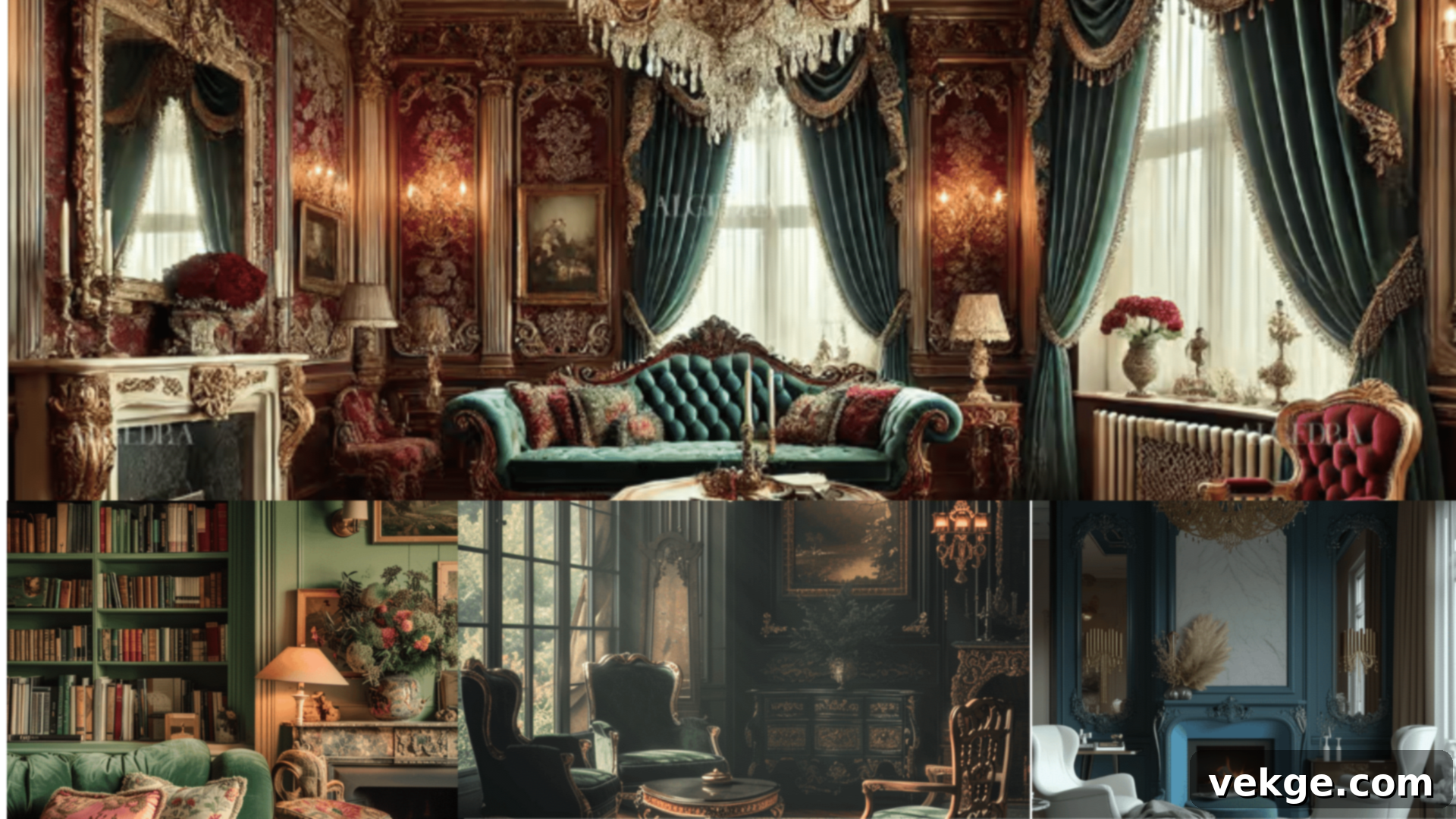Victorian Living Room Ideas: Create Timeless Elegance & Opulence in Your Home
Victorian-style living rooms are more than just spaces; they are grand narratives woven with threads of history, luxury, and intricate beauty. These magnificent rooms transport you to an era of refined taste, filling your home with a symphony of rich colors, exquisitely crafted furniture, and sparkling decorative accents. Imagine a space where every object tells a story, and every detail contributes to an atmosphere of unparalleled comfort and sophistication.
This comprehensive guide is your essential companion to understanding and embracing the allure of Victorian living rooms. We will delve deep into every aspect, from selecting the most ornate furniture pieces to discovering those exclusive decorative touches that define this iconic style. Whether you dream of a fully authentic Victorian parlor or wish to infuse subtle historical charm into a modern setting, this guide will illuminate your path.
Join us as we explore how the Victorians meticulously crafted these breathtaking spaces, which continue to inspire homeowners and designers today. If you’re eager to invite the timeless elegance and sophisticated charm of the Victorian era into your own living space, then this blog will provide you with all the insights and inspiration you need to truly grasp and execute the vision.
Prepare to be inspired by an abundance of amazing ideas designed to transform your living room into a sanctuary of Victorian grandeur. From the soft luxury of antique rugs to the radiant gleam of gilded mirrors, you’ll unlock the secrets to creating a room that masterfully blends historic authenticity with modern comfort, offering a unique and inviting atmosphere.
Key Features of a Victorian Living Room
Victorian living rooms were meticulously designed as formal spaces, each element imbued with intricate details and a sense of gravitas. They were characterized by a pervasive use of dark, rich wood furniture and heavy, often patterned curtains that lent a sense of intimacy and grandeur. Walls were typically adorned with elaborately patterned wallpaper, adding layers of texture and visual interest to the space.
No surface was left bare; plants, decorative items, and curated collections filled every available space, reflecting the Victorian penchant for collecting and display. Fireplaces served as the undeniable focal point of the room, almost always featuring highly ornate mantels that were masterpieces of carving or marble work. Furniture included iconic pieces like button-tufted sofas and armchairs, often featuring gracefully curved wooden legs, all crafted for both comfort and aesthetic impact.
The prevailing color palette was bold and sumptuous, featuring deep reds, emerald greens, and shimmering golds that created a warm and inviting yet undeniably luxurious ambiance. Plush, heavy rugs covered hardwood floors, adding another layer of comfort and intricate pattern. Lighting, initially provided by oil lamps and candles, cast a soft, golden glow, enhancing the cozy and somewhat mysterious atmosphere of these magnificent rooms.
Furniture Choices
Victorian living rooms were furnished with heavy, imposing, and elaborately ornate pieces that spoke volumes of the homeowner’s status and taste. Sofas, often upholstered in rich fabrics like velvet, damask, or brocade, featured distinctive curved wooden legs and deep button-tufting that added both comfort and a sophisticated textural element. These pieces were not merely functional but artistic statements.
Armchairs were typically oversized, designed for maximum comfort with deep seats and high, supportive backs, perfect for long evenings of reading or conversation. Side tables and coffee tables were meticulously crafted from dark, noble woods such as mahogany, walnut, or rosewood, often showcasing intricate carvings and detailed inlays. These tables were essential for displaying treasured items and holding drinks or books.
Elaborate cabinets with glass doors, known as display cabinets or curio cabinets, were prominent features, used to proudly exhibit fine china, collectible figurines, and exotic curiosities from travels. Every piece of furniture was built with exceptional sturdiness and longevity in mind, reflecting the era’s appreciation for quality craftsmanship. Matching furniture sets were highly fashionable, creating a cohesive and opulent look throughout the room. The wooden frames of these pieces frequently boasted elegant curved lines and decorative details, serving as a testament to the skill and artistry of Victorian woodworkers.
Color Schemes
Victorian living rooms embraced bold, rich, and deeply saturated color schemes that enveloped spaces in a sense of warmth, grandeur, and undeniable fanciness. Deep red, often a symbol of passion and luxury, was an exceptionally popular choice for walls, upholstery, and drapery, creating a dramatic and enveloping effect. Dark green brought the richness of nature indoors, evoking lush forests and adding an earthy yet regal tone. Royal blue contributed an aristocratic richness to rooms, often paired with gold for a truly regal effect. Gold accents, whether on picture frames, mirrors, or decorative moldings, caught the light beautifully, adding a luminous sparkle that enhanced the overall opulence. Plush purple hues, traditionally associated with royalty, signified wealth and luxury, used sparingly or as a dominant color in more extravagant designs.
Brown tones, naturally present in the abundant dark wood furniture and paneling, grounded the space and added a comforting, natural element. Black details, often found in ironwork or as outlines in patterns, created strong, sophisticated contrasts, adding definition and drama. These darker, richer colors were not only aesthetically pleasing but also practical; they skillfully masked the soot and grime that inevitably accumulated in homes heated by coal fires. Furthermore, these opulent colors were frequently combined and intertwined in complex patterns found on wallpaper, sumptuous rugs, and heavy, elaborate curtains, creating a layered and visually stimulating environment that was distinctly Victorian.
Lighting
Victorian living rooms utilized a diverse array of lighting solutions, each designed to cultivate a warm, inviting, and distinctly fancy ambiance. At the heart of most grand living rooms, crystal chandeliers hung majestically from the center of the ceiling. These magnificent fixtures, adorned with countless facets of glass or crystal, served as dazzling focal points, openly proclaiming the homeowner’s wealth and sophisticated style by refracting light into myriad sparkles across the room. Complementing these central fixtures were elegant wall sconces, often featuring small, decorative shades that diffused soft, ambient light around the perimeter of the room, contributing to a gentle glow.
Tabletops were graced with beautiful oil lamps, frequently designed with colorful glass bases or intricate metalwork, providing focused pools of light. Delicate candle holders, crafted from polished brass or sterling silver, added a soft, flickering glow, enhancing the cozy and intimate atmosphere. As technology advanced, gas lighting became increasingly popular, integrated into wall-mounted fixtures that offered a brighter yet still warm illumination. The overall effect of this varied lighting, often dim and golden, made rooms feel inherently cozy, romantic, and imbued with a sense of mysterious charm. Lampshades of the era often featured ornate details like fringe or beads, designed not only to beautify but also to further soften and diffuse the light, creating a truly enchanting glow.
Ideas for Victorian Style Living Room
Embracing a Victorian style living room means curating a space rich with fancy items, profound history, and artistic flair. Think grand rugs that anchor the room, gold-framed mirrors that reflect elegance, and sumptuous velvet curtains that cascade with luxury. Crystal lights glitter with timeless sophistication, while dark wood furniture exudes warmth and heritage. Here are 41 amazing ideas to help you achieve that coveted Victorian look, each offering a unique way to infuse your home with historical charm and opulence.
1. Antique Rugs
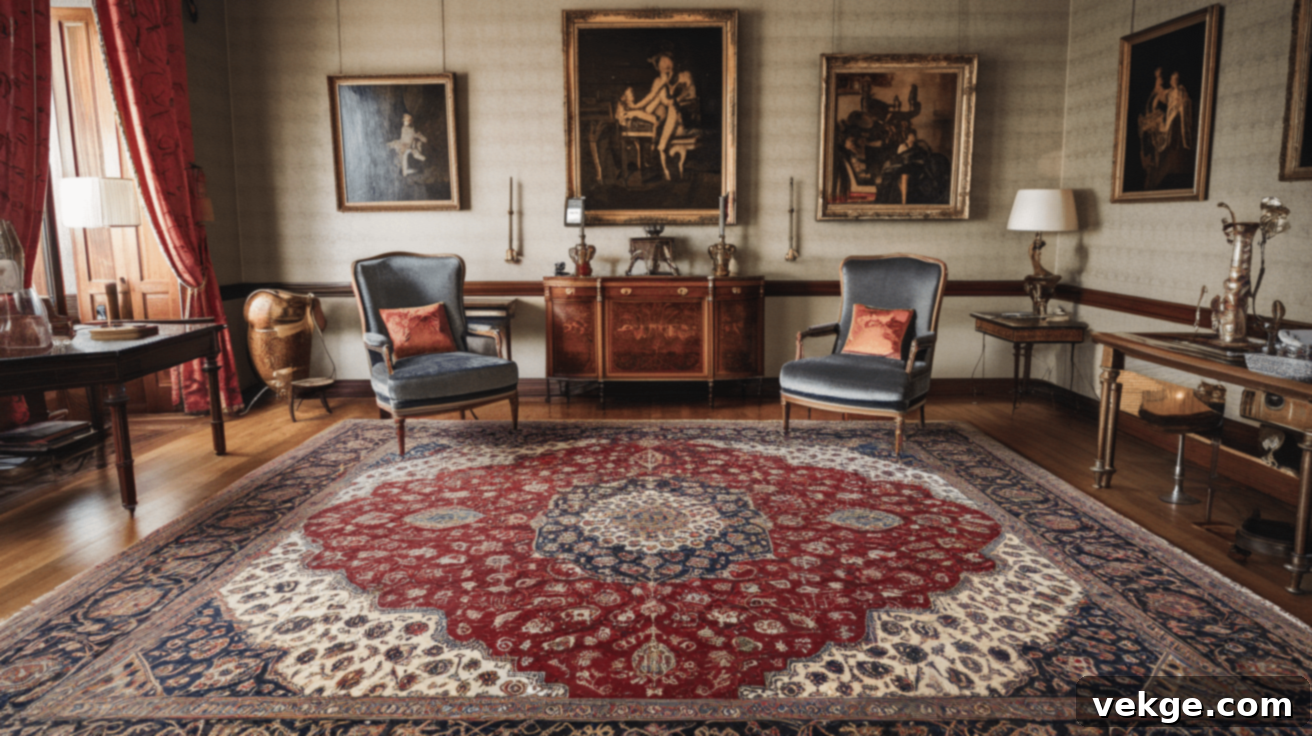
Rugs were absolutely central to the design and comfort of Victorian living rooms, acting as both insulation and a canvas for elaborate patterns. Incorporating Persian and Oriental rugs instantly injects an authentic Victorian charm into any space. These rugs are renowned for their intricate designs and rich, deep colors, such as classic reds, blues, and golds, which were highly favored during the era.
Beyond their aesthetic appeal, antique rugs make rooms feel profoundly warm, welcoming, and luxuriously cozy. Their thick, plush fabric not only adds a tactile texture but also significantly softens footsteps, bringing a quiet elegance to hardwood floors. Even a strategically placed smaller rug beneath a coffee table can make a considerable impact, defining a seating area and adding a layer of historical authenticity.
Achieving this look doesn’t necessarily require an authentic, high-priced antique. Many reputable companies today produce new rugs featuring faithfully reproduced old-fashioned patterns and color schemes. These modern interpretations offer the desired Victorian aesthetic without the significant investment or delicate care required for genuine antiques, making timeless style accessible on any budget.
2. Stained Glass Windows
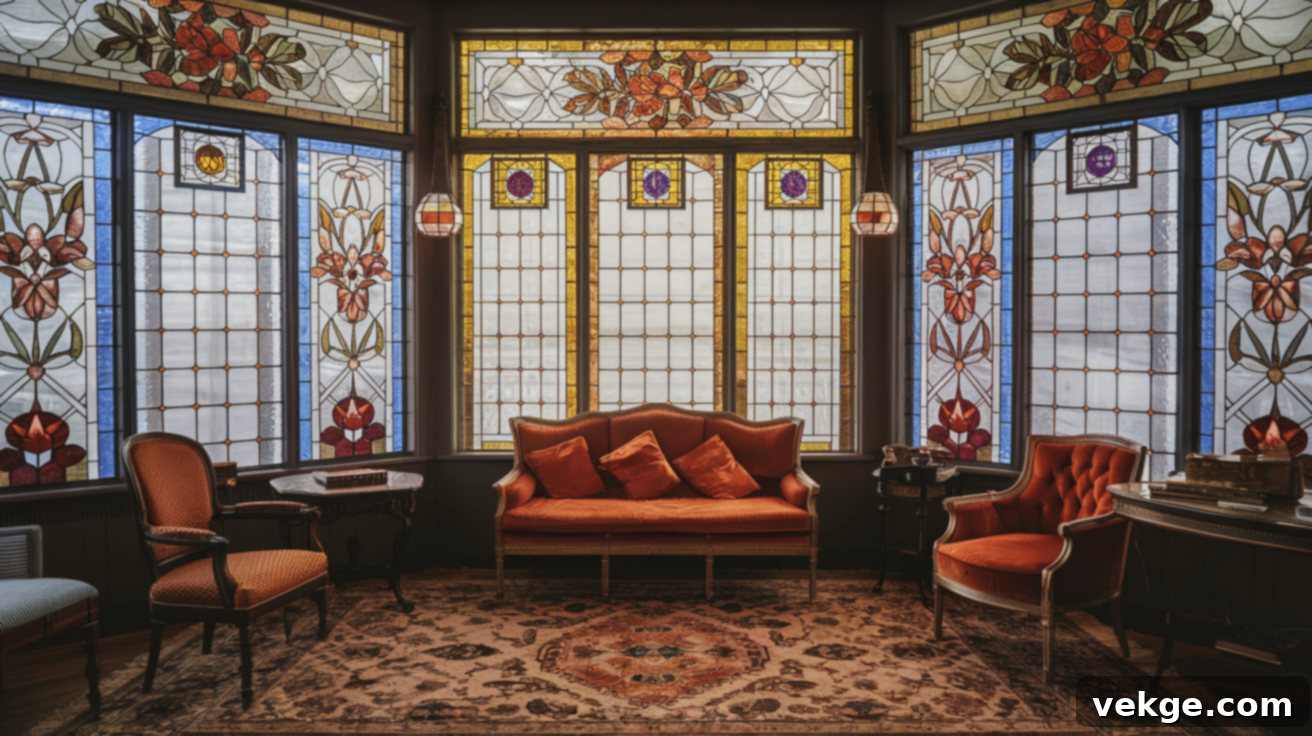
Victorians were captivated by the artistic beauty of stained glass windows, viewing them as both a source of light and a decorative art form. These colorful glass panels allowed natural light to filter into rooms, creating a mesmerizing play of patterns and hues. When sunlight streams through them, these windows literally paint vibrant rainbow colors across your room, transforming the ambiance into something magical and ethereal.
You don’t need to undertake a major renovation to integrate this stunning feature into your home. A simpler, more accessible approach is to hang small, pre-made stained glass panels in existing window frames. Alternatively, look for charming stained glass sun catchers, which can be easily attached to plain windows with suction cups, offering a pop of color and historical flair.
For a budget-friendly and flexible option, several companies offer window films designed to mimic the intricate appearance of stained glass. These films adhere directly to your plain windowpanes, providing the desired visual effect without the high cost or permanence of actual stained glass. They are also easy to remove, allowing you to change your decor whenever inspiration strikes.
3. Gilded Mirrors
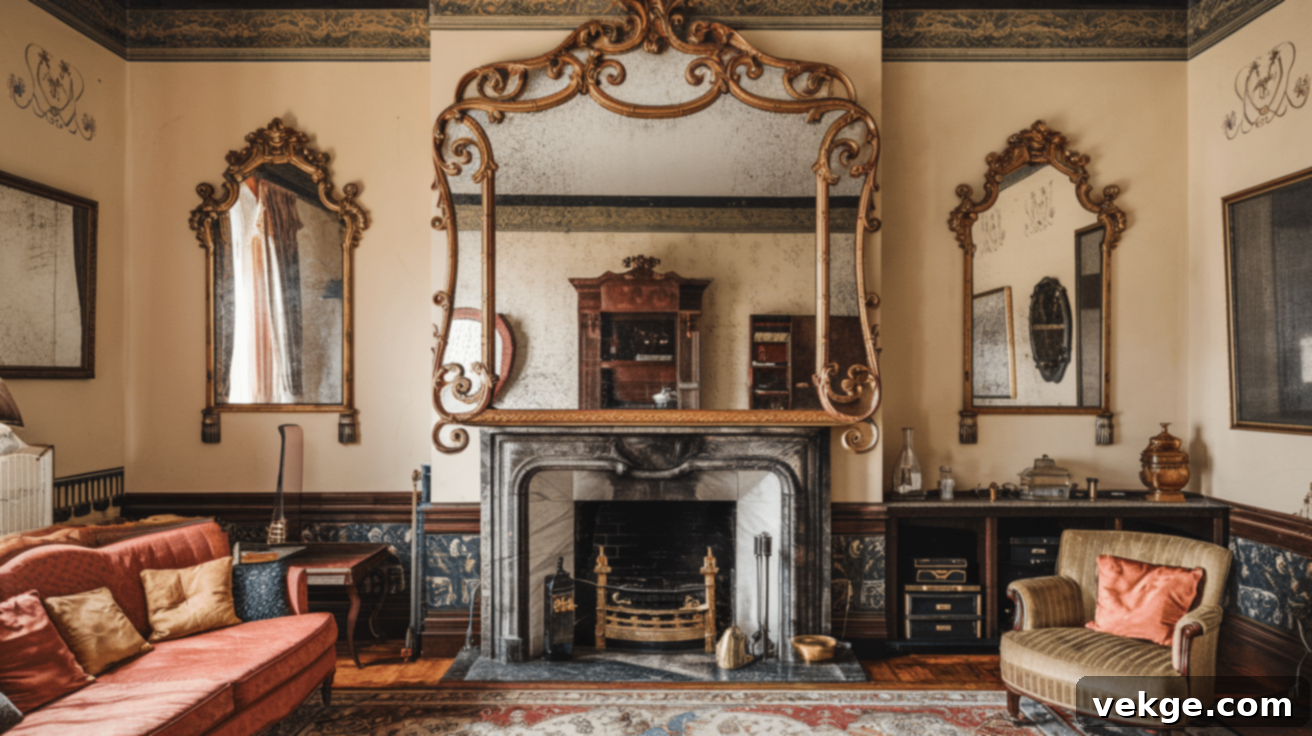
Gilded mirrors were indispensable elements in Victorian living rooms, serving as both functional items and significant decorative statements. These exquisite mirrors were housed within opulent frames, lavishly adorned with elaborate swirls, delicate floral motifs, and gracefully curving leaves, all covered in rich gold paint or authentic gold leaf. Such mirrors immediately conveyed a sense of luxury and artistic sophistication.
A generously sized gilded mirror positioned above your fireplace instantly becomes a powerful focal point, drawing the eye and commanding attention in the room. Smaller gilded mirrors can be artfully arranged on any wall to add subtle sparkle and visual interest, contributing to the layered aesthetic typical of Victorian interiors.
Beyond their decorative appeal, mirrors also cleverly manipulate space, making rooms appear larger and significantly brighter by reflecting natural and artificial light. To find these treasures, explore antique shops, flea markets, or thrift stores, where you might uncover authentic pieces with rich histories. For a more budget-friendly approach, consider purchasing a plain mirror and applying gold paint or gold leaf to the frame yourself, allowing you to create a bespoke Victorian touch with a personal flair.
4. Velvet Curtains
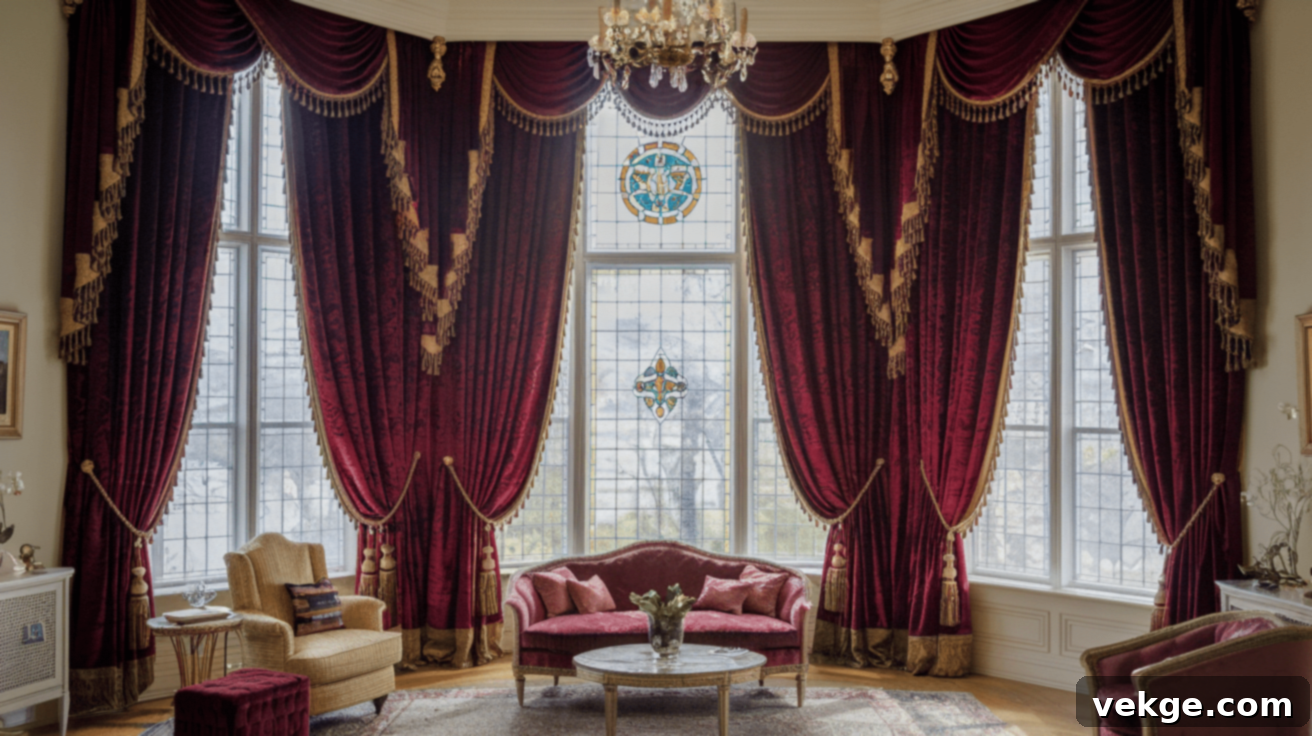
Velvet curtains were a beloved and essential feature in Victorian living rooms, embodying both luxurious aesthetics and practical functionality. These thick, sumptuously soft curtains typically cascaded from ceiling to floor, creating a dramatic visual impact that made windows appear grand and stately. The inherent richness of velvet fabric immediately communicates opulence and also provides excellent light-blocking capabilities, crucial for privacy and managing sunlight.
Victorians preferred deep, jewel-toned colors for their velvet drapery, such as profound dark red, rich forest green, or regal royal blue, colors that enhanced the room’s luxurious ambiance. They often embellished these curtains with elaborate trims, decorative braids, and elegant tassels along the edges, adding another layer of intricate detail and textural interest.
Even in contemporary homes, velvet curtains instantaneously evoke a Victorian sensibility. They are not just decorative; their heavy fabric effectively insulates, keeping rooms warmer during winter months and darker for improved sleep or media viewing. The simple act of framing your windows with velvet curtains can elevate even the most minimalist modern room, infusing it with a sense of historical richness and refined taste.
5. Crystal Chandeliers
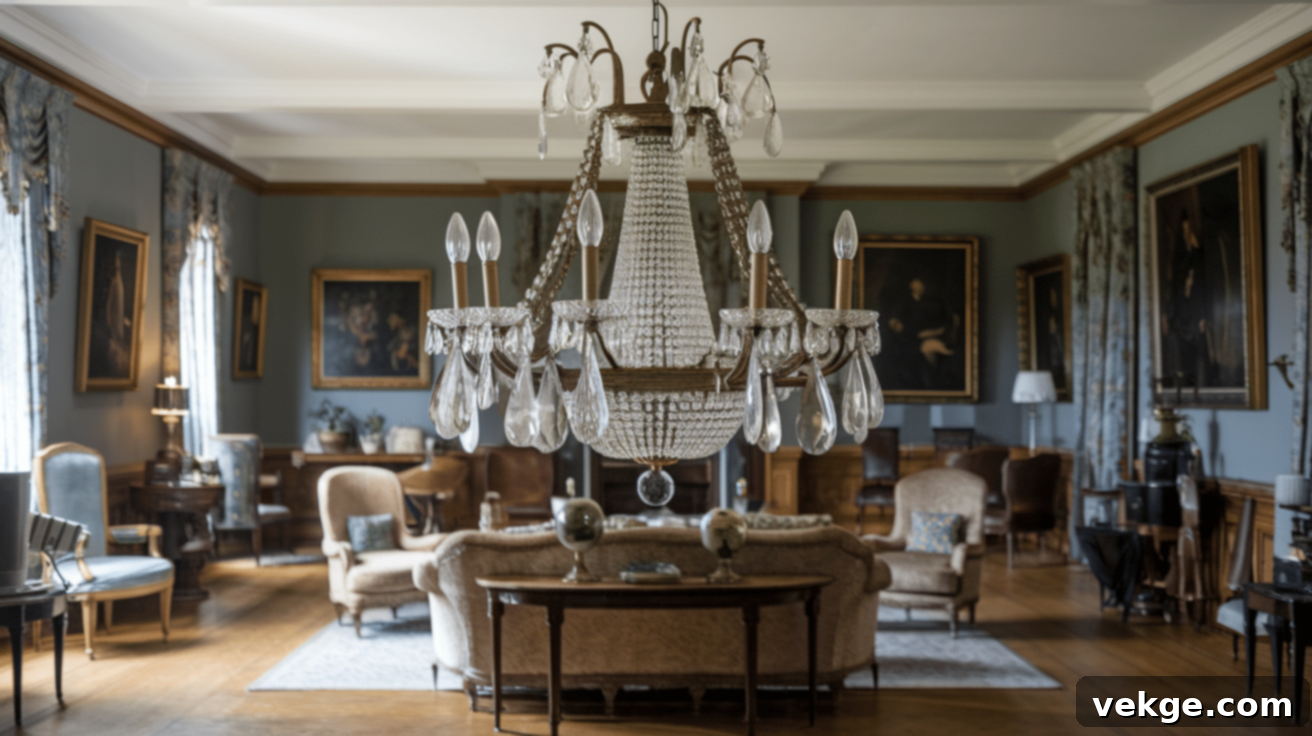
Crystal chandeliers were truly the crown jewels of Victorian living rooms, serving as magnificent centerpieces that illuminated and adorned the space. These exquisite hanging light fixtures were composed of numerous meticulously cut glass or crystal pieces, designed to sparkle and refract light brilliantly when illuminated, creating a dazzling spectacle of light and shadow. Each chandelier, with its multitude of facets, artfully scattered tiny rainbows across the room, filling the space with a magical, ethereal glow.
A crystal chandelier makes a powerful and elegant statement in any room, instantly drawing the eye upward and imparting an air of instant sophistication and grandeur. You don’t necessarily need a monumental chandelier; smaller, more discreet versions can work wonderfully in today’s homes, providing a touch of Victorian glam without overwhelming the space. Modern crystal chandeliers are available in a vast array of styles, catering to various tastes and room sizes.
Some contemporary designs feature electric “candles” that mimic the warm, flickering glow of real flames, while others cleverly blend crystal with metallic elements for an updated yet still distinctly Victorian aesthetic. Regardless of size or modern adaptation, a crystal chandelier remains a quintessential element for capturing the opulent essence of Victorian lighting.
6. Decorative Wall Panels
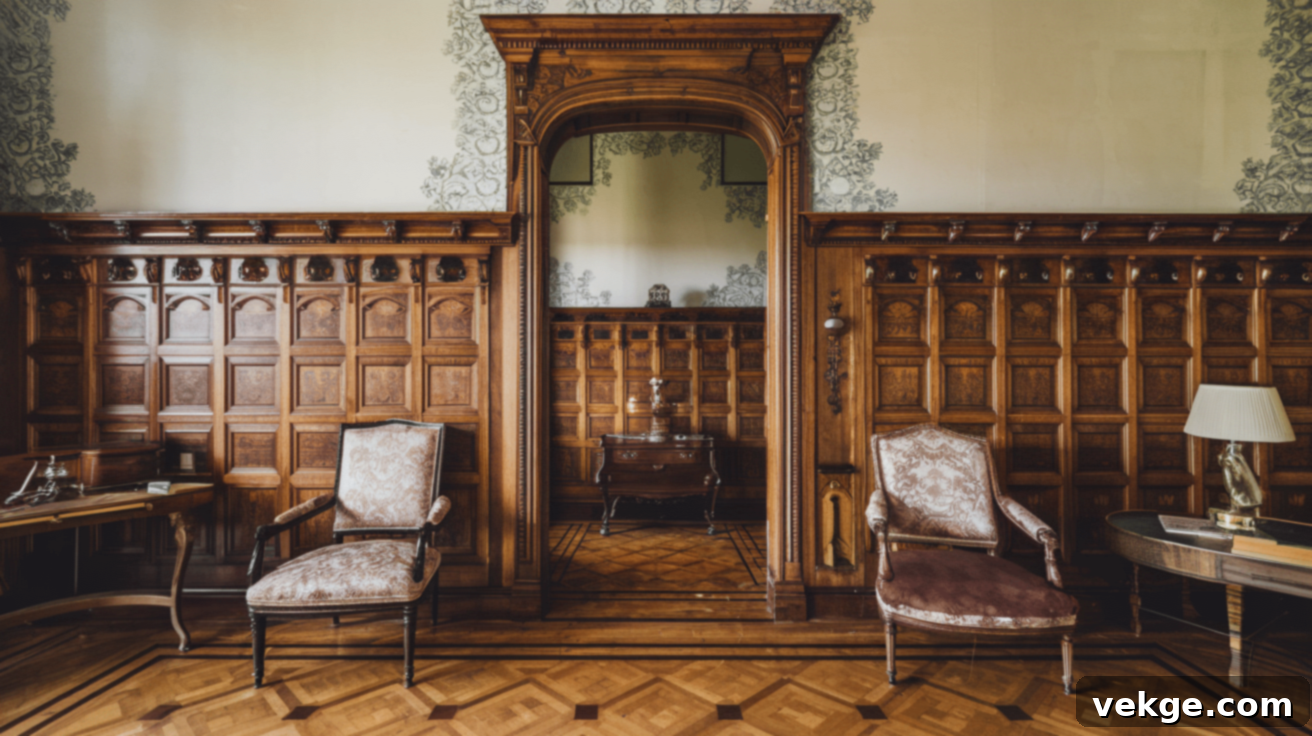
Victorians held a deep appreciation for elaborate wall treatments, and decorative wall panels were a favored method to impart a sense of richness and style to their rooms. These panels, often crafted from wood, featured intricate patterns and designs that could extend halfway up the walls in the form of wainscoting, or sometimes even cover entire walls for a more immersive and opulent effect. This architectural detail added depth, texture, and a refined finish to any Victorian interior.
Today, you can replicate this classic look using traditional wood panels or wainscoting, which adds immediate character and historical authenticity. Some panels feature exquisitely carved designs that create a sophisticated three-dimensional effect, literally making the walls stand out. Others are simpler, forming elegant squares or rectangles through applied moldings, offering a more understated yet still classic appearance. For a less labor-intensive option, consider wallpaper designed to mimic the look of carved panels, providing the aesthetic without the carpentry.
Even easier still, stick-on panels made of plastic or foam are available, offering a convincing panelled look without requiring significant effort or specialized tools. These alternatives make it possible to achieve the desired Victorian charm, adapting it to modern convenience and varying budgets.
7. Oil Paintings
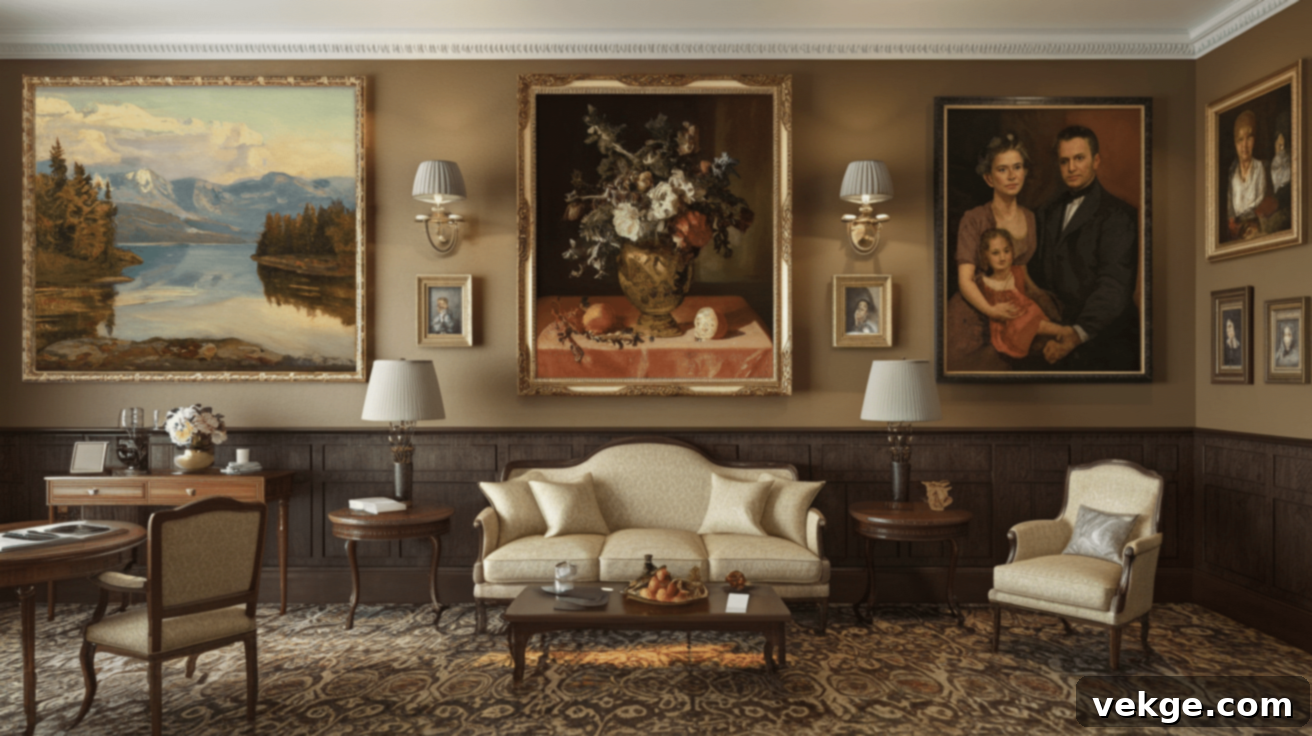
Victorians took immense pleasure in adorning their living rooms with a curated collection of oil paintings, showcasing their artistic sensibilities and social standing. These artworks typically depicted serene landscapes, vibrant floral arrangements, or dignified family portraits, all elegantly housed within elaborate gold frames that amplified their grandeur. The paintings were usually hung on walls using a sophisticated system of picture rails, from which special hooks and cords suspended the artwork, allowing for flexible arrangements without damaging the plaster.
It was common for Victorians to group several paintings together in a charming cluster, creating a gallery wall effect that added layers of visual interest and personalized storytelling. To emulate this look affordably, you can seek out vintage-style prints that convincingly resemble genuine oil paintings. Thrift stores, estate sales, and online marketplaces are excellent sources for discovering old paintings at reasonable prices, offering a chance to uncover unique pieces with history.
When selecting artwork, look for classic subjects such as tranquil nature scenes, detailed still lifes featuring fruit or flowers, or romantic depictions of boats on water. To complete the Victorian aesthetic, always ensure your chosen artwork is presented in a prominent gold frame, which will instantly elevate its appearance and integrate it seamlessly into your period-inspired decor.
8. Framed Photographs
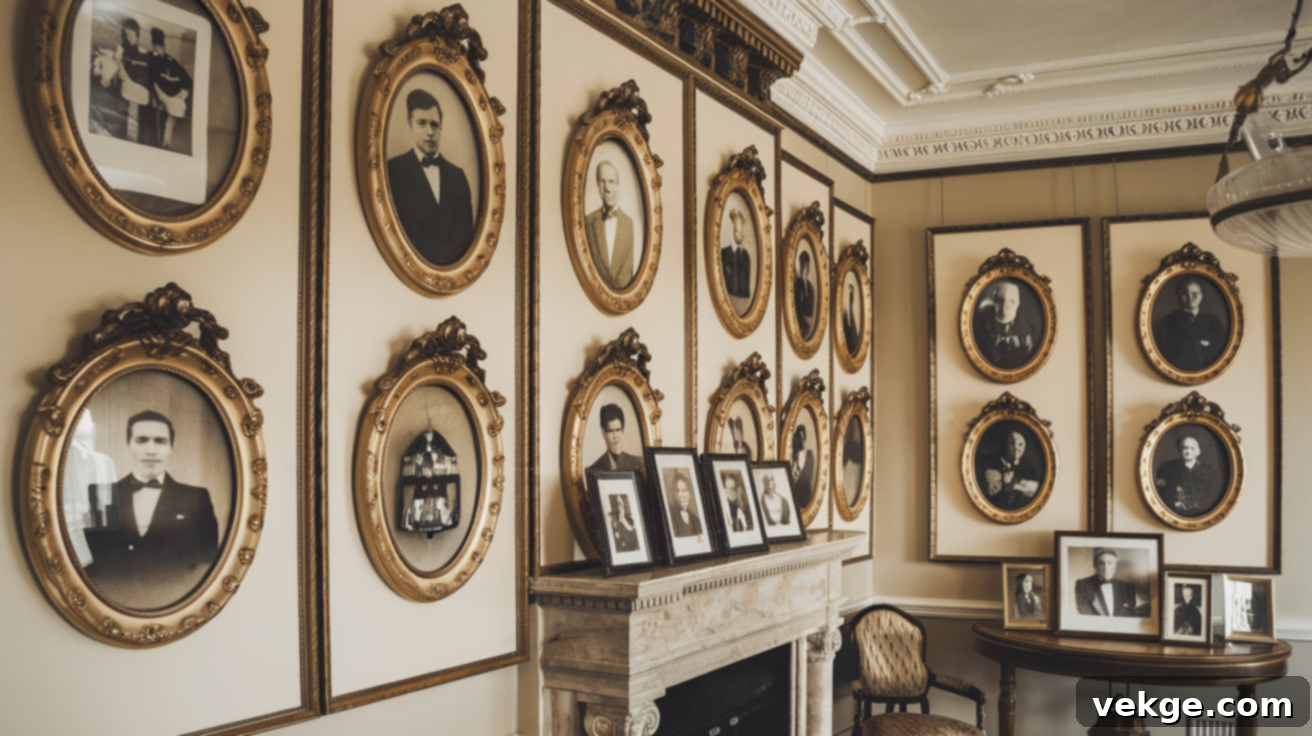
The display of framed photographs was a cherished tradition in Victorian living rooms, celebrating family, milestones, and personal connections. Victorians used richly decorated frames, often featuring intricate carved details and elegant curved edges, to showcase their cherished images. These framed photographs were prominently placed on mantels, side tables, and display shelves, becoming intimate focal points within the grandeur of the room.
You can effortlessly recreate this sentimental and stylish look using your own family photos. For an authentic old-fashioned feel, consider converting your color pictures to black and white or sepia tones. Grouping several smaller frames together on a wall or a tabletop creates a charming vignette that instantly draws the eye and evokes a sense of history.
When selecting frames, prioritize those with ornate corners, intricate moldings, and gracefully curved edges. Silver and gold frames are particularly effective in capturing the authentic Victorian aesthetic, adding a touch of metallic luster. For a truly period-authentic touch, seek out oval-shaped frames, which were highly popular during the era. Modern technology can also assist; numerous apps and filters are available that can transform your digital photos to appear as if they were taken during Victorian times, blending seamlessly into your historical decor.
9. Carved Wood Furniture
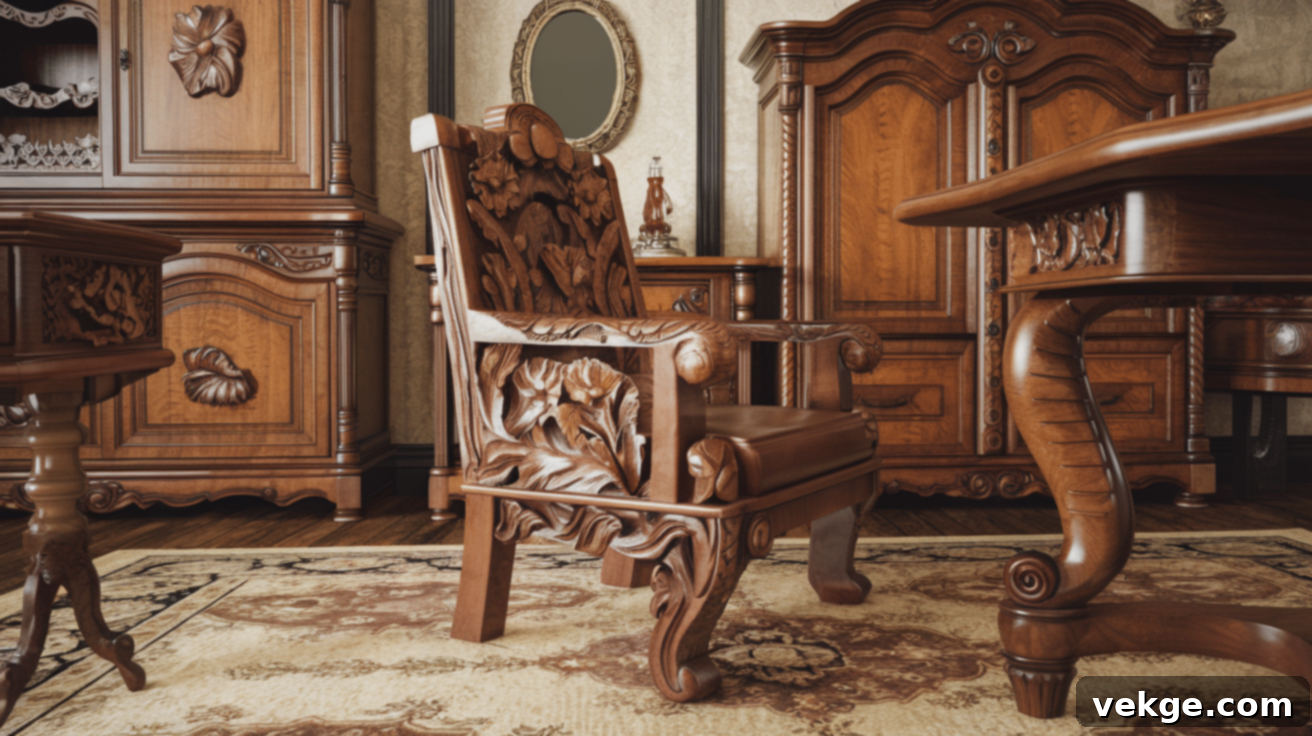
Victorian furniture was synonymous with exquisite and elaborate wood carvings, a hallmark of the era’s craftsmanship and a clear indicator of wealth and good taste. Tables, chairs, and cabinets were not merely functional items but works of art, adorned with detailed designs depicting flowers, swirling leaves, grotesque figures, and graceful curving shapes. These intricate carvings showcased the skill of the artisan and the owner’s appreciation for fine details.
The most commonly used woods were dark, rich varieties such as walnut, mahogany, and rosewood, which provided a robust base for the detailed work and added to the furniture’s imposing presence. When looking to incorporate this style, seek out chairs with beautifully carved backs, tables with decoratively turned or sculpted legs, or a substantial sideboard featuring intricately carved doors. Even a single piece of ornately carved furniture can dramatically elevate a modern room, instantly infusing it with Victorian character.
Affordable versions can often be found at antique shops, estate sales, or online marketplaces, offering a chance to own a piece of history. Furthermore, many contemporary furniture manufacturers now produce pieces that skillfully replicate these cherished old-fashioned carved designs, making Victorian elegance accessible for today’s homes without the challenges of sourcing authentic antiques.
10. Antique Clocks
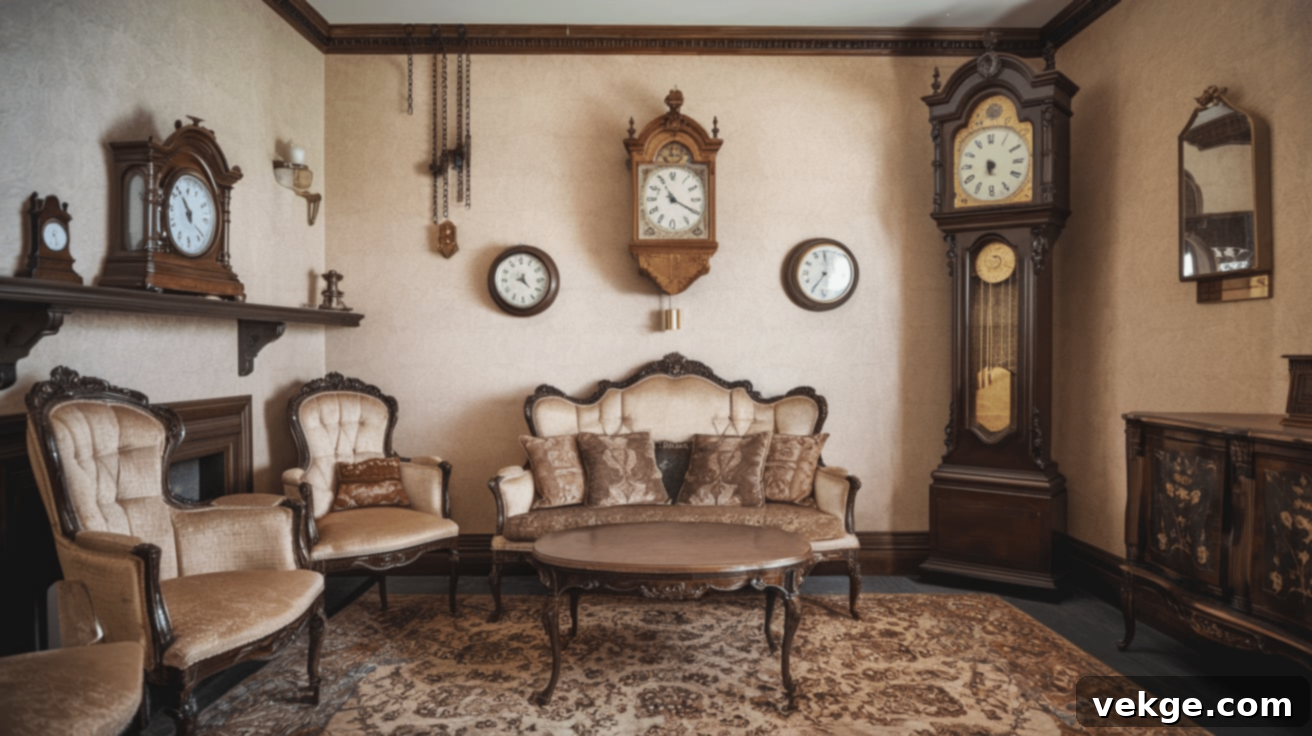
Antique clocks were not just time-telling devices in Victorian living rooms; they were esteemed decorative objects, meticulously crafted and proudly displayed. Mantel clocks, often ornate and encased in rich wood or polished brass, held pride of place on fireplace shelves, serving as captivating centerpieces. Tall, majestic grandfather clocks stood elegantly in corners, their imposing presence and rhythmic chimes adding to the room’s character. Wall clocks, often with intricate faces and decorative frames, hung in prominent spots, ensuring that time was always visible and stylishly presented.
These clocks typically featured sophisticated wood or metal cases, often adorned with carvings, turned pillars, or detailed inlays. Many showcased classic Roman numerals on their faces and sometimes even revealed visible, intricate moving parts, fascinating viewers with their mechanical beauty. The gentle, steady swing of a pendulum added a serene rhythm to the household, a constant reminder of the passage of time.
Today, incorporating an antique clock instantly imbues any room with a sense of Victorian charm and historical gravitas. Even if the clock is no longer in working order, its aesthetic value remains profound. For those seeking the look without the antique price tag, modern reproductions offer the same classic appearance for a more accessible cost. The soft, rhythmic ticking of an antique clock can bring a peaceful, old-fashioned feeling to your home, creating an auditory link to the past.
11. Tassels and Fringes
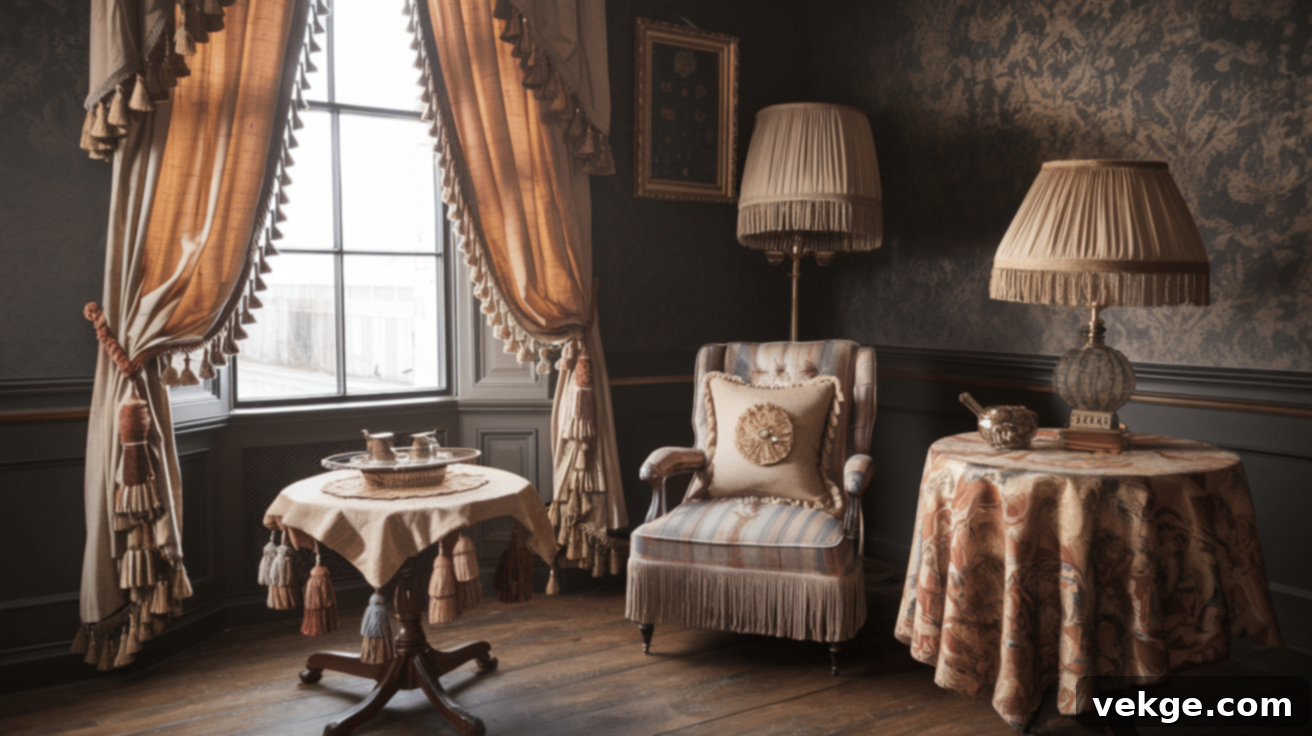
Victorians possessed an undeniable fondness for adding luxurious tassels and decorative fringes to almost every conceivable textile and furnishing. These elegant dangling embellishments adorned the edges of sumptuous curtains, plush pillows, intricate tablecloths, and even delicate lampshades, adding a touch of playful opulence and movement to stationary items. Tassels, typically composed of neatly bundled threads or cords tied at one end, and fringes, which are rows of hanging threads or loops attached along an edge, both contributed significantly to the layered, textural richness characteristic of Victorian interiors.
Integrating these details into your modern Victorian scheme is surprisingly simple and impactful. You can easily purchase tassels from craft stores and sew them onto cushions, throw pillows, or the hems of existing curtains to add an instant bespoke feel. Alternatively, look for ready-made curtains and lampshades that already feature these embellishments, saving you time and effort.
Even a single fringed throw blanket draped artfully over your sofa can introduce a distinct Victorian flair to an otherwise modern room, adding a soft, inviting texture and a hint of historical luxury. These seemingly small decorative details, often overlooked, can make a remarkably big difference in establishing an authentic and opulent Victorian atmosphere.
12. Wingback Chairs
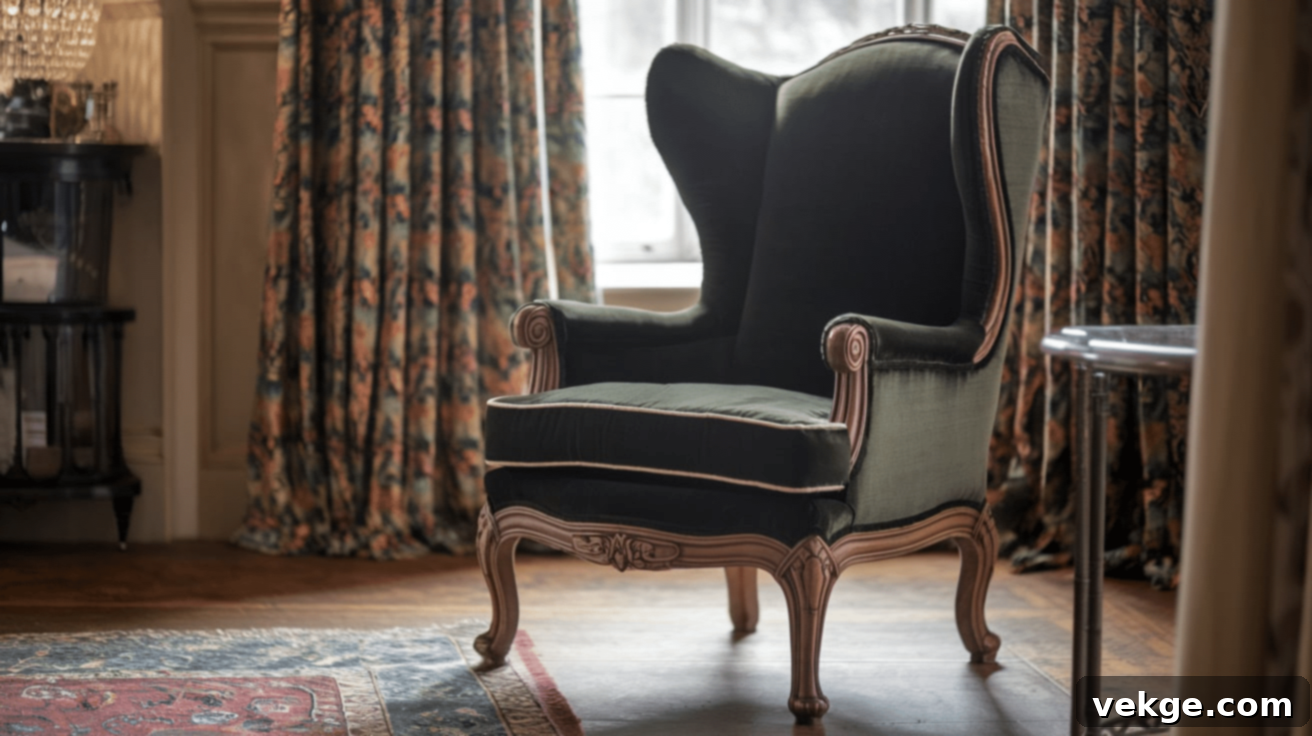
Wingback chairs were exceptionally popular and highly functional pieces of furniture in Victorian living rooms, cherished for their distinctive design and inherent comfort. These iconic chairs are characterized by their tall backs and the signature “wings” or panels that curve gracefully forward on both sides, creating a sheltered and cozy enclosure. Originally, these wings served a practical purpose: they effectively blocked cold drafts from fireplaces and doorways, keeping the sitter warm and snug.
Victorians upholstered these chairs in rich, luxurious fabrics such as velvet, leather, or patterned brocade, further enhancing their opulent appearance and tactile appeal. They often featured classic button tufting on the backrest and elegant carved wooden legs, contributing to their refined aesthetic. Today, wingback chairs continue to exude timeless elegance and can beautifully complement any room, whether traditional or contemporary.
They make excellent, inviting reading chairs, particularly when positioned beside a crackling fireplace or a sun-drenched window. You can find both authentic antique versions with rich histories and newly manufactured chairs with Victorian-inspired designs that blend seamlessly into modern decor. Incorporating even a single wingback chair instantly adds a touch of sophisticated Victorian charm and stately presence to your living space, inviting relaxation in style.
13. Sculpted Figurines

Victorians had a keen passion for collecting and displaying an array of small sculptures and decorative figurines, turning their living rooms into personal galleries of treasured objects. These delicate items were proudly showcased on mantelpieces, various tables, and display shelves throughout the home, adding character and visual interest to every available surface. Porcelain figurines, often depicting elegant ladies in period attire, charming children, or scenes from classical mythology, were particularly popular and highly prized.
Beyond human figures, small animal sculptures crafted from bronze, ceramic, or cast iron also found their way into Victorian homes, contributing to the eclectic and layered decor. Many figurines depicted scenes from beloved myths, famous literary works, or historical events, making them conversation starters and artistic statements. You can discover similar charming figurines at antique shops, flea markets, or estate sales, offering a chance to own a piece of that decorative history.
For the most authentic Victorian display, try grouping three or five figurines together, varying their heights and forms to create a pleasing vignette. Even a single, carefully chosen special piece can significantly enhance a room’s Victorian charm. Look for sculptures of dancers, gracefully posed animals, or classical figures distinguished by fine details and delicate features, which truly capture the refined artistic sensibilities of the era.
14. Baroque Mirrors

Baroque-style mirrors were highly prized and treasured possessions in Victorian homes, recognized for their extravagant beauty and dramatic presence. These magnificent mirrors are characterized by their exceptionally ornate frames, which are lavishly adorned with elaborate swirls, abundant floral motifs, and intricate scrolling designs. The style, originally from the Baroque period, experienced a strong revival during the Victorian era, appealing to the period’s love for grandeur and embellishment.
Gold was by far the most popular and coveted color for these opulent frames, lending a radiant, luxurious sheen that commanded attention. Victorians frequently hung large baroque-style mirrors above their fireplaces, establishing them as powerful focal points that reflected light and added depth to the room. Smaller baroque mirrors were strategically placed on walls throughout the living room, contributing to the overall sense of decorative abundance and sparkle. These mirrors not only made rooms appear larger but also masterfully reflected candlelight and gaslight, significantly brightening spaces and enhancing their warm, inviting glow.
You can find stunning baroque-style mirrors in antique stores, where you might uncover authentic pieces with genuine historical patina, or explore modern reproductions available in most home decor shops. Even a single, well-placed statement mirror with an elaborate frame can dramatically transform a plain wall. Remember, the more detailed and elaborate the frame, the more authentically you will capture the opulent and dramatic essence of the Victorian look.
15. Decorative Candelabras
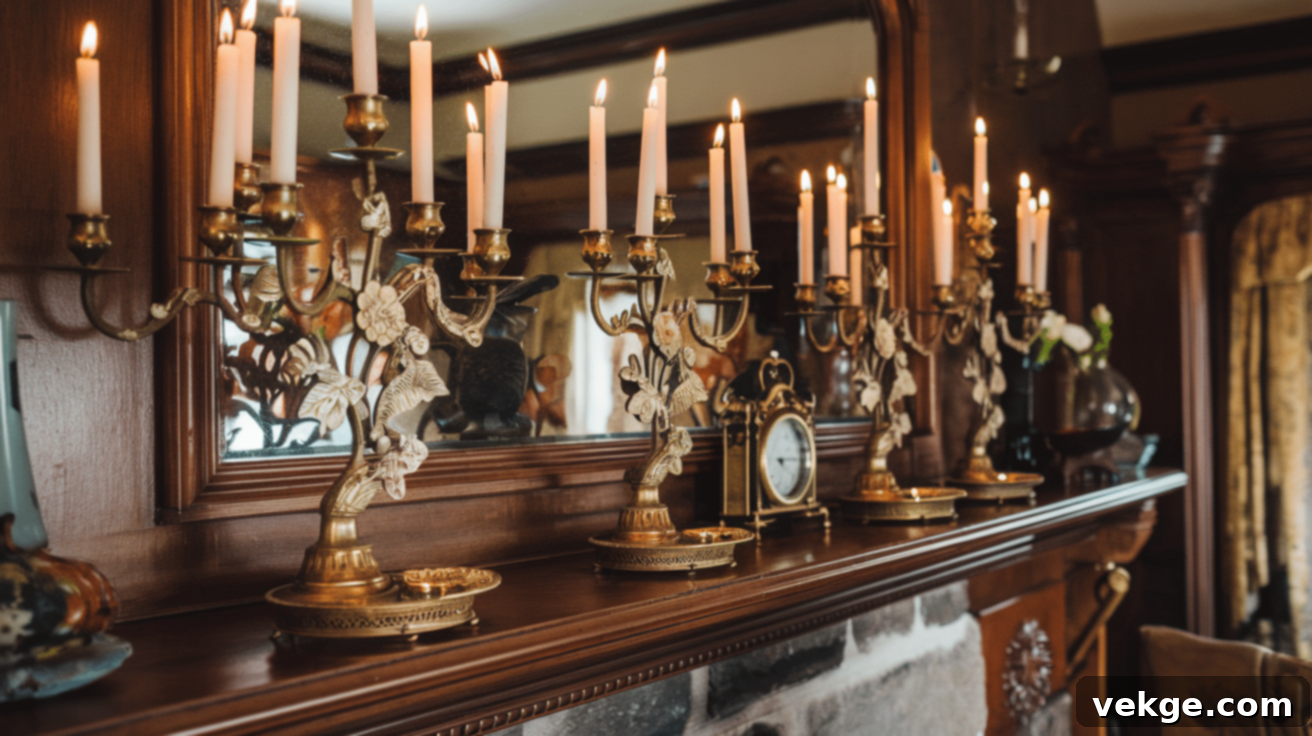
Candelabras played a significant role in illuminating Victorian living rooms, serving as both practical light sources and exquisite decorative objects. These elaborate candleholders typically featured multiple arms, designed to hold several candles simultaneously, thus amplifying the light output and creating a captivating display. Crafted from luxurious materials such as polished silver, gleaming brass, or sparkling crystal, candelabras were symbols of sophistication and wealth.
They often boasted intricate designs, including delicate floral patterns, elegant scrollwork, or classical motifs, showcasing the detailed craftsmanship of the era. Some practical designs even included small dishes or bobeches beneath each candle to catch dripping wax, preventing damage to furniture. Today, incorporating candelabras instantly adds an authentic Victorian charm and a touch of dramatic elegance to any setting. They are perfectly placed on mantelpieces, as grand centerpieces on dining tables, or on side tables, where their height and form can truly be appreciated.
You have the option of using traditional wax candles for an authentic flickering glow or opting for safer, battery-operated LED candles that realistically mimic real flames without any fire risk or mess. Even unlit, these elegant pieces contribute height, grandeur, and a sophisticated sculptural element to any room. Their shiny, reflective surfaces beautifully catch and play with ambient light, further enhancing the room’s overall luminosity and opulence.
16. Crystal Vases
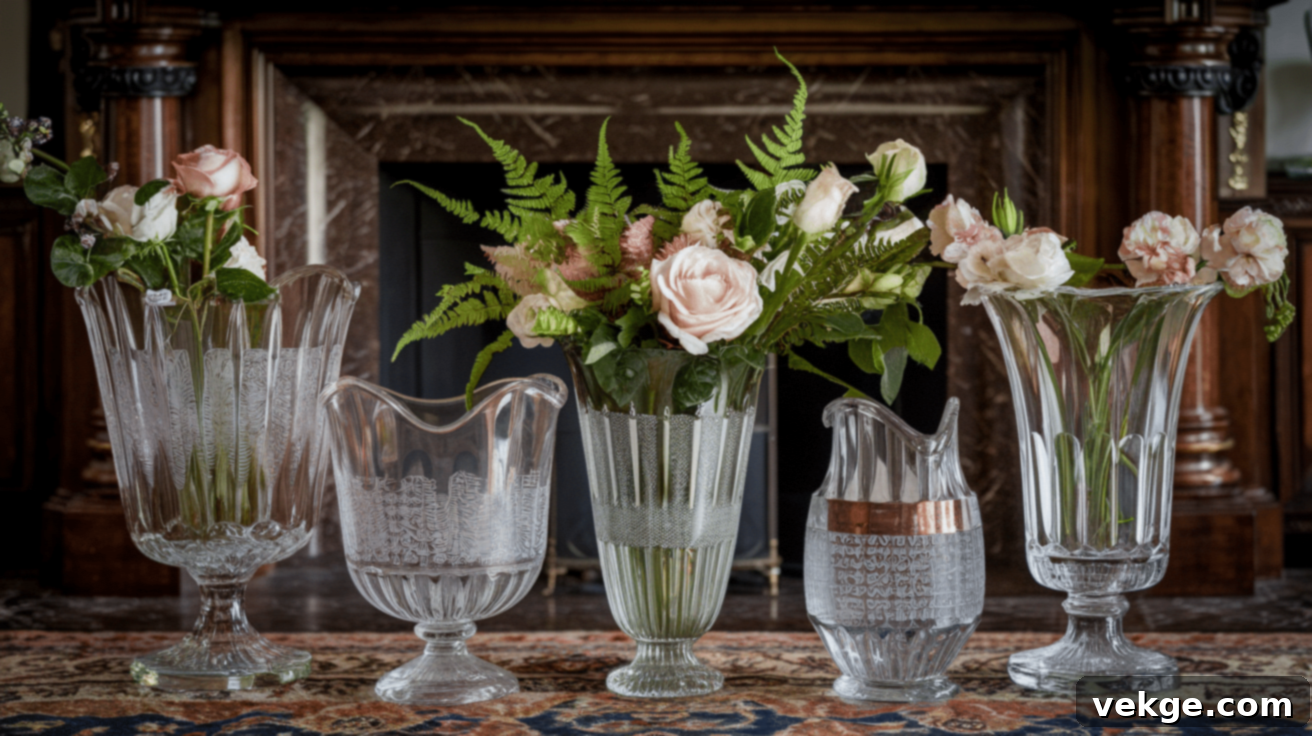
Crystal vases were essential decorative items in Victorian living rooms, revered for their sparkling beauty and ability to elevate any floral arrangement. These exquisite glass containers were typically filled with fresh flowers, often sourced from the homeowner’s own meticulously maintained gardens or acquired from local florists, bringing the beauty of nature indoors. Victorians particularly admired cut crystal, which featured intricate patterns and facets designed to magnificently catch and refract light, creating a dazzling display of brilliance.
Tall, elegant vases were prominently displayed on mantelpieces and various tables, serving as striking focal points. Smaller bud vases were often grouped together, each holding a single delicate bloom or a small cluster of flowers, adding a touch of refined charm to more intimate settings. Today, crystal vases continue to imbue any space with instant Victorian elegance and sophistication. To achieve the most authentic look, fill them with classic Victorian flowers such as lush roses, stately lilies, delicate ferns, or fragrant hyacinths.
Even when left empty, their gleaming surfaces beautifully brighten any room, reflecting light and adding a subtle shimmer. You can often discover affordable crystal vases at antique shops, thrift stores, or estate sales, offering a chance to acquire genuine vintage pieces. Look for vases with intricate etched patterns, detailed cut designs, or multifaceted sides that brilliantly create rainbow reflections, truly capturing the luxurious essence of Victorian crystalware.
17. Lace Doilies

Lace doilies were an omnipresent and cherished element in Victorian living rooms, symbolizing domesticity, delicate craftsmanship, and a meticulous approach to home decor. These small, typically round or oval fabric pieces featured exquisitely delicate patterns, often with intricate openwork, created through a variety of lace-making techniques. It was a common and beloved pastime for women of the era to hand-make these doilies using fine cotton thread, showcasing their needlework skills.
Practically, doilies served an important function: they protected valuable furniture surfaces from scratches, heat, and spills, especially under vases, lamps, and decorative figurines. Beyond protection, they added a layer of softness and intricate beauty to dark, heavy wooden furniture. Some larger doilies were even draped over the backs and arms of chairs and sofas, protecting upholstery and adding a decorative flourish.
Today, white or cream-colored doilies instantly contribute a touch of authentic Victorian charm and feminine grace. Place them strategically on wooden tables, polished sideboards, or on the arms of dark-upholstered furniture to highlight their delicate patterns. You can easily find vintage doilies at antique shops, flea markets, or craft fairs, or purchase new ones from craft stores. Even incorporating just a few small doilies can bring a delicate, quaint, and distinctly Victorian touch to modern rooms, softening contemporary lines with historical elegance.
18. Victorian Wall Sconces
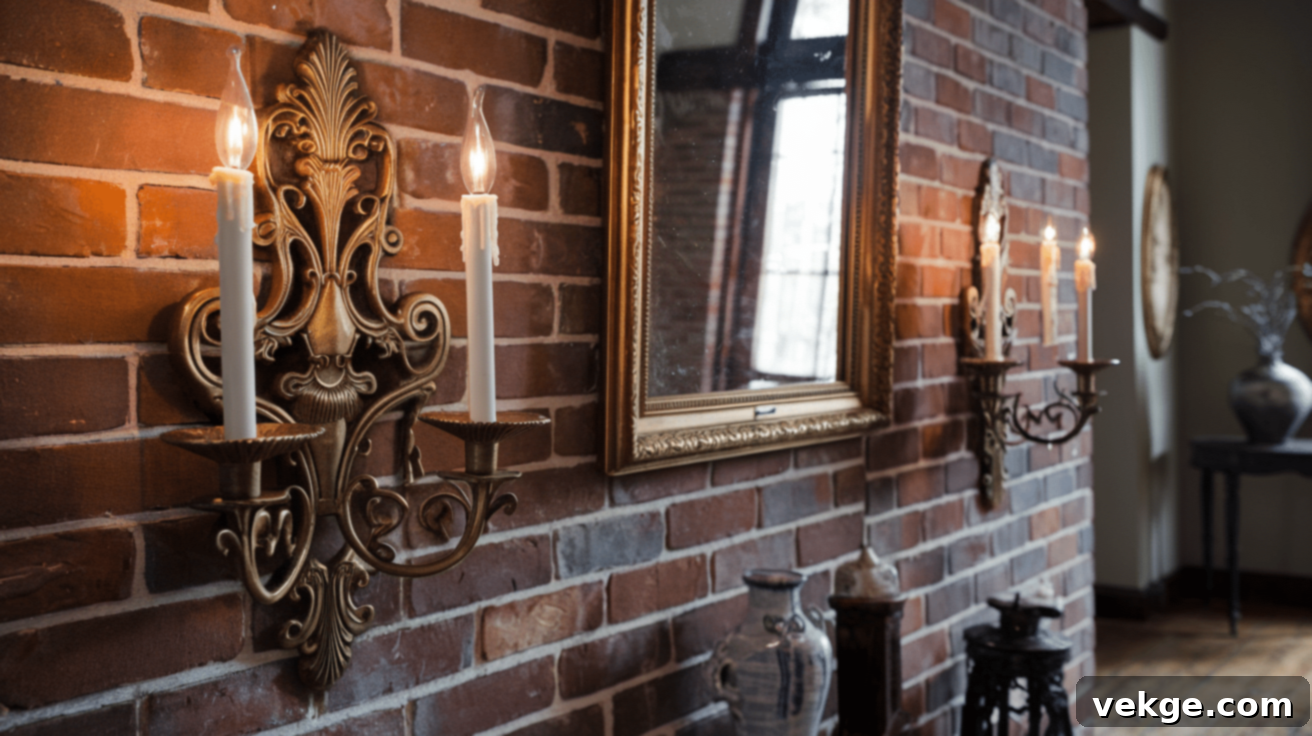
Wall sconces were a practical and elegant lighting solution that became increasingly popular in Victorian homes, offering ambient illumination without occupying valuable table or floor space. These decorative light fixtures attached directly to the walls, enhancing the room’s atmosphere with a softer, diffused glow. Victorian sconces were typically crafted with elaborate metalwork, often in materials like polished brass, rich bronze, or sturdy cast iron, showcasing intricate designs and a refined aesthetic.
Many early designs mimicked the appearance of traditional candle holders, later adapted to accommodate gas jets and then electric bulbs, often featuring charming glass shades to protect the light source and soften its output. Some particularly grand sconces even incorporated small mirrors behind them, designed to reflect and magnify the light, thereby increasing the overall brightness of the room. Today, wall sconces are an excellent way to introduce soft, warm, and historical lighting to living rooms, contributing to a layered lighting scheme.
You can find modern electric versions that are designed to replicate the look of old gas lamps, complete with vintage-style bulbs for an authentic glow. Position them symmetrically on either side of a large mirror, a prominent fireplace, or a significant artwork to create a balanced and elegant visual statement. Even a single pair of ornate sconces can instantly add authentic Victorian charm and sophisticated ambiance to any modern wall, elevating the room’s character.
19. Carved Mantelpieces
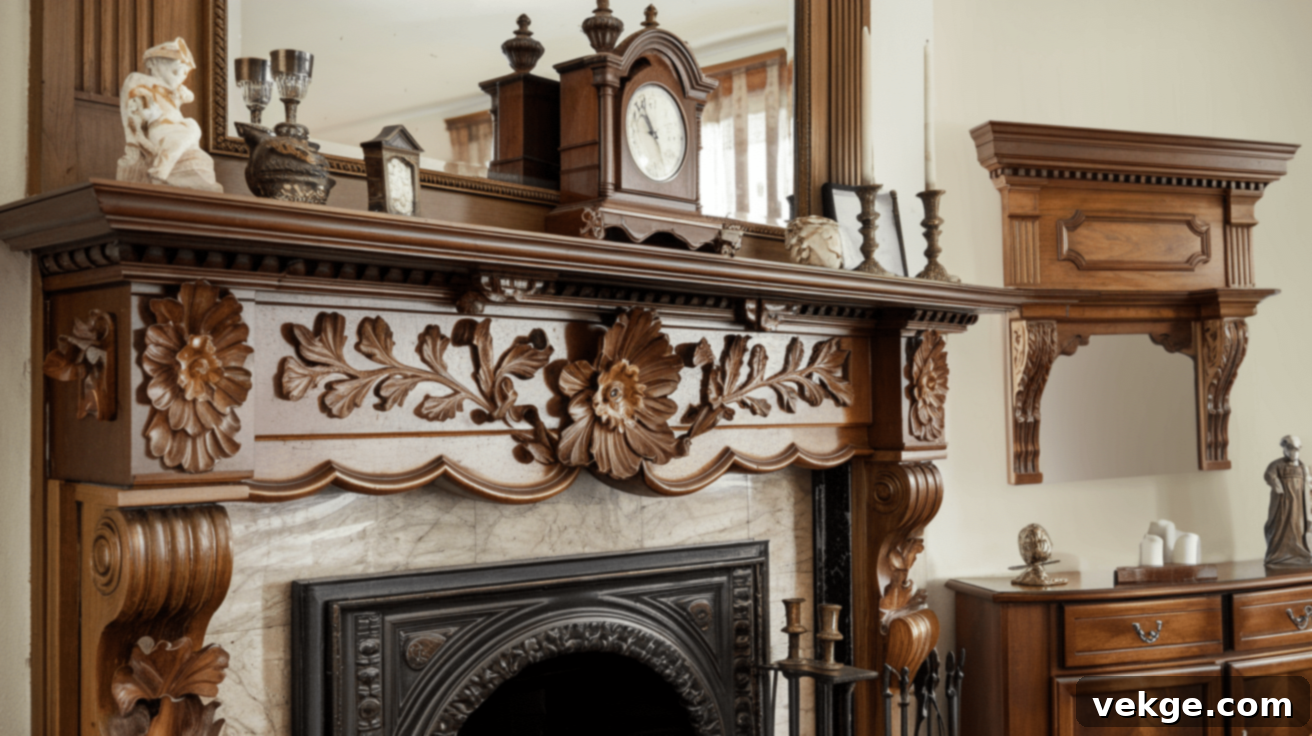
The mantelpiece was undeniably the star attraction and central focal point of Victorian living rooms, acting as the heart around which the entire room’s design revolved. These prominent shelves, situated above the fireplace opening, were often elaborately carved from rich wood or stately stone, showcasing exceptional craftsmanship. Their fronts and sides were typically adorned with an abundance of decorative motifs, including lush flowers, swirling leaves, classical garlands, and intricate swirling patterns, each detail contributing to its grandeur.
The mantel served as the primary display area for the homeowner’s most prized possessions. Victorians meticulously arranged their finest items here, such as ornate mantel clocks, elegant candelabras, delicate porcelain figurines, and small, cherished statues, creating a carefully curated vignette. Above the mantel, a grand mirror or a significant oil painting almost invariably hung, further enhancing its visual importance.
Today, incorporating a carved mantelpiece can dramatically transform any room, instantly infusing it with historical character and warmth. If replacing your entire fireplace is not feasible, consider adding a standalone wooden mantel shelf with decorative brackets above your existing hearth. Alternatively, explore options for a faux fireplace surround, complete with a Victorian-style mantel, that can be placed against a flat wall, offering the aesthetic appeal without the functional fireplace. This design element is crucial for capturing the quintessential Victorian living room ambiance.
20. Decorative Screens
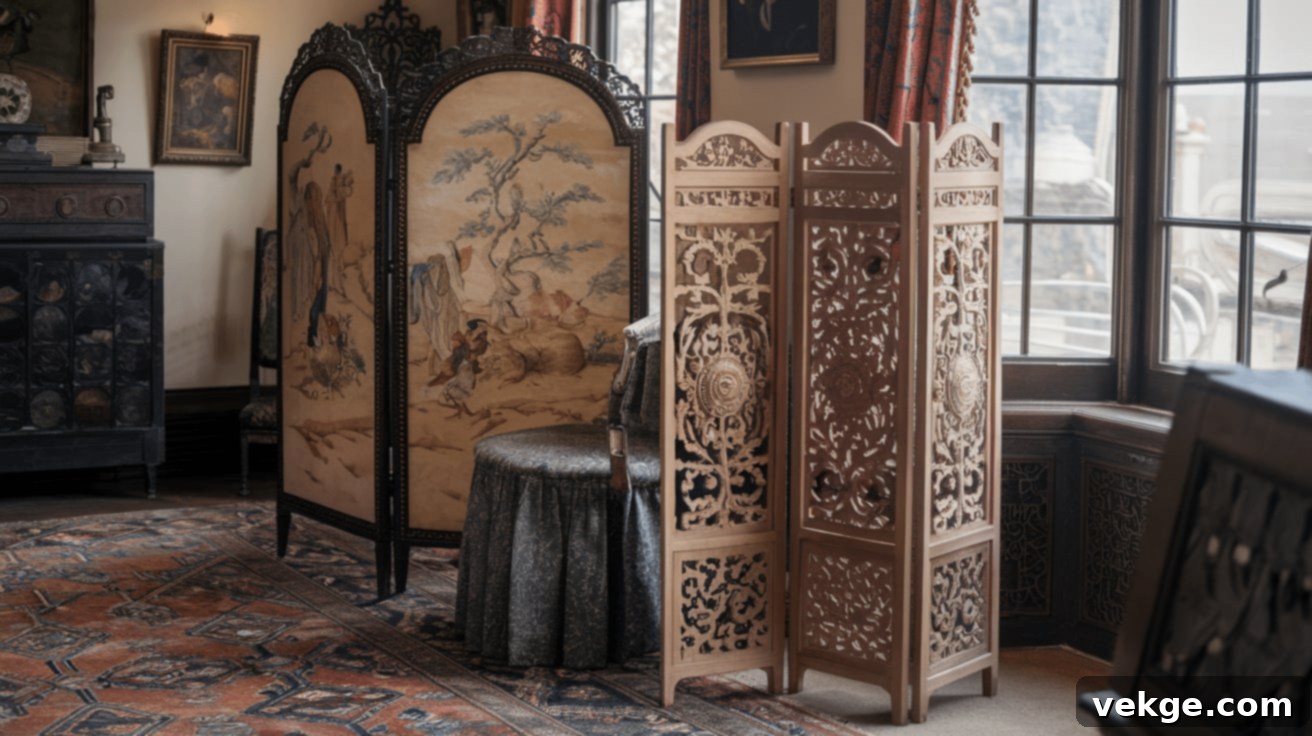
Folding screens were an elegant and versatile addition to Victorian living spaces, bringing a touch of magic and practicality. They were expertly used to create intimate, cozy corners within larger, open rooms, or to gracefully delineate different functional areas. Decorative screens offered not only visual privacy but also infused the space with an air of sophisticated charm and artistic beauty.
To capture this look, select screens featuring detailed wood carvings, intricate fretwork, or exquisitely painted silk panels. These panels often displayed delicate floral patterns, scenic landscapes, or elaborate geometric designs, all rendered in rich, period-appropriate colors. Such screens could ingeniously hide unsightly or messy areas, or beautifully divide a grand room into more manageable and inviting sections, such as a reading nook or a private conversation area.
Victorian screens were renowned for their rich colors, intricate designs, and exceptional craftsmanship, making them true statement pieces. Strategically place them near windows to filter light, or behind furniture arrangements to define a zone. These decorative screens are far more than mere room dividers; they are stunning works of art that eloquently tell stories of classic style, adding depth, texture, and a touch of historical intrigue to your interior.
21. Glass Cloches
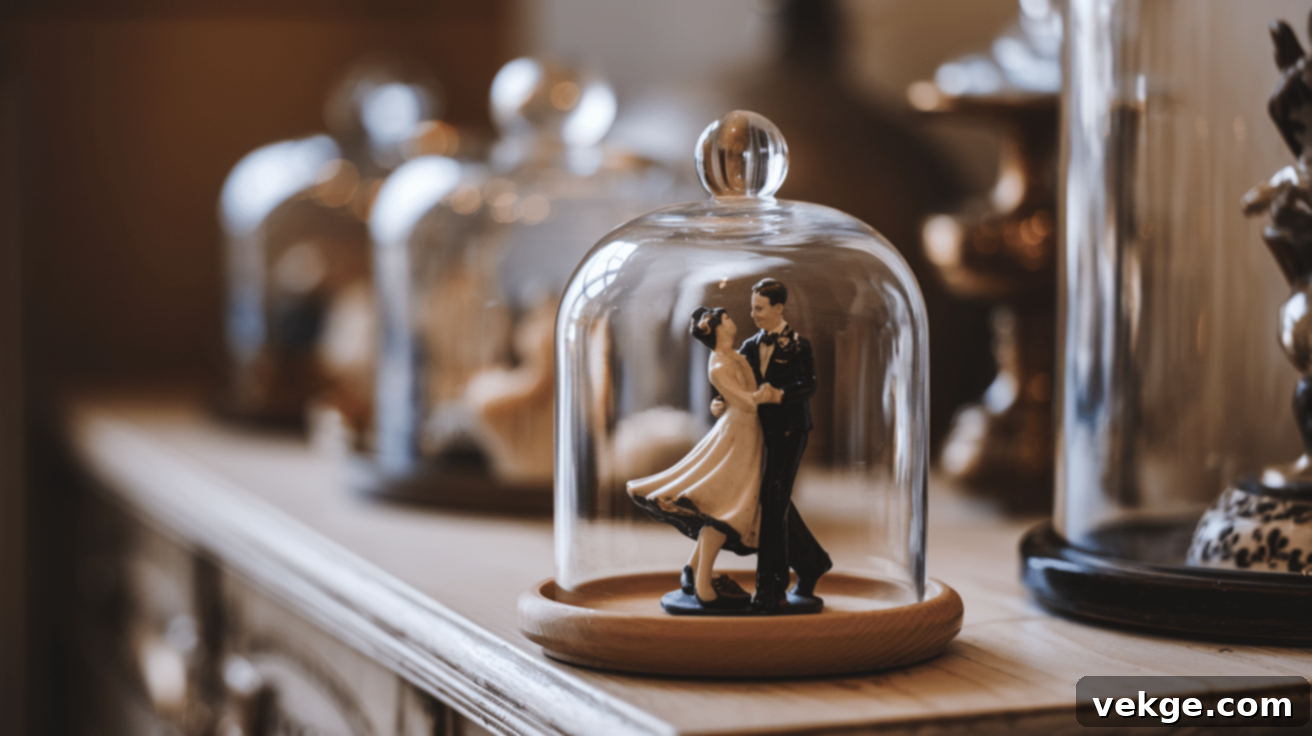
Glass cloches were a charming and sophisticated accessory in Victorian homes, adding a touch of fancy flair and an element of curated display to any room. These clear, bell-shaped covers were primarily used to protect and beautifully showcase special, delicate items, preserving them from dust and curious hands while enhancing their visual importance. Victorians loved collecting a myriad of pretty things – from vintage figurines and delicate pressed flowers to small exotic treasures and intricate wax fruit arrangements – all of which found a perfect home under a glass cloche.
Place these elegant covers on side tables, mantelpieces, or shelves, turning your cherished objects into miniature museum exhibits. Beyond their protective function, cloches create an immediate sense of intrigue and importance around the items they house, inviting closer inspection. Victorian homes excelled at displaying small, beautiful objects under glass, transforming everyday collections into artistic arrangements.
Each cloche, with its carefully chosen contents, tells a silent story of elegance, careful curation, and a deep appreciation for beauty. Incorporating them into your living space allows you to celebrate your own collections with a distinct nod to historical display practices, adding a refined and thoughtful layer to your decor.
22. Marble-Topped Tables
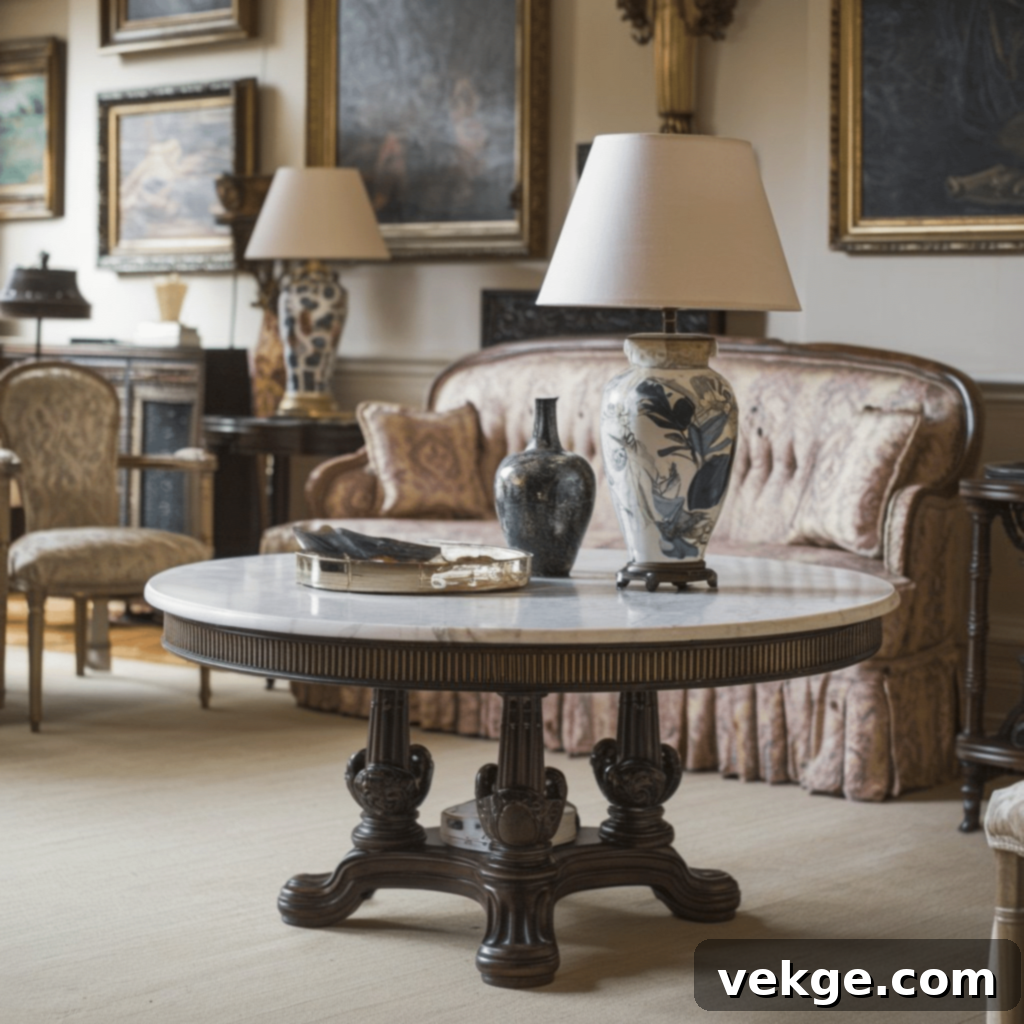
Marble-topped tables were a quintessential sign of luxury and refinement in Victorian living rooms, instantly elevating the aesthetic of any space. These exquisite tables, often featuring bases of dark carved wood or intricate cast iron, boasted smooth, cool marble surfaces that shimmered with an inherent elegance. Each marble top was unique, resembling a natural work of art with its distinctive veining and subtle variations in color.
White marble, with its pristine surface and delicate grey lines, offered a classic and bright counterpoint to the generally darker Victorian interiors, while darker marbles, such as green or black, contributed deep, rich colors and a more dramatic presence. Strategically place these tables next to sofas, armchairs, or in quiet corners to serve as elegant surfaces for a variety of items. They provided perfect spots for resting delicate tea cups, displaying treasured books, or showcasing beautiful decorative accents like a vase of flowers or a small figurine.
Victorian homes reveled in showcasing beautiful, high-quality furniture, and marble tables were prime examples of this dedication to luxurious craftsmanship. These tables do more than provide a surface; they eloquently tell stories of elegance, enduring style, and an appreciation for natural beauty, adding a touch of timeless grandeur to your living room.
23. Antique Tea Sets
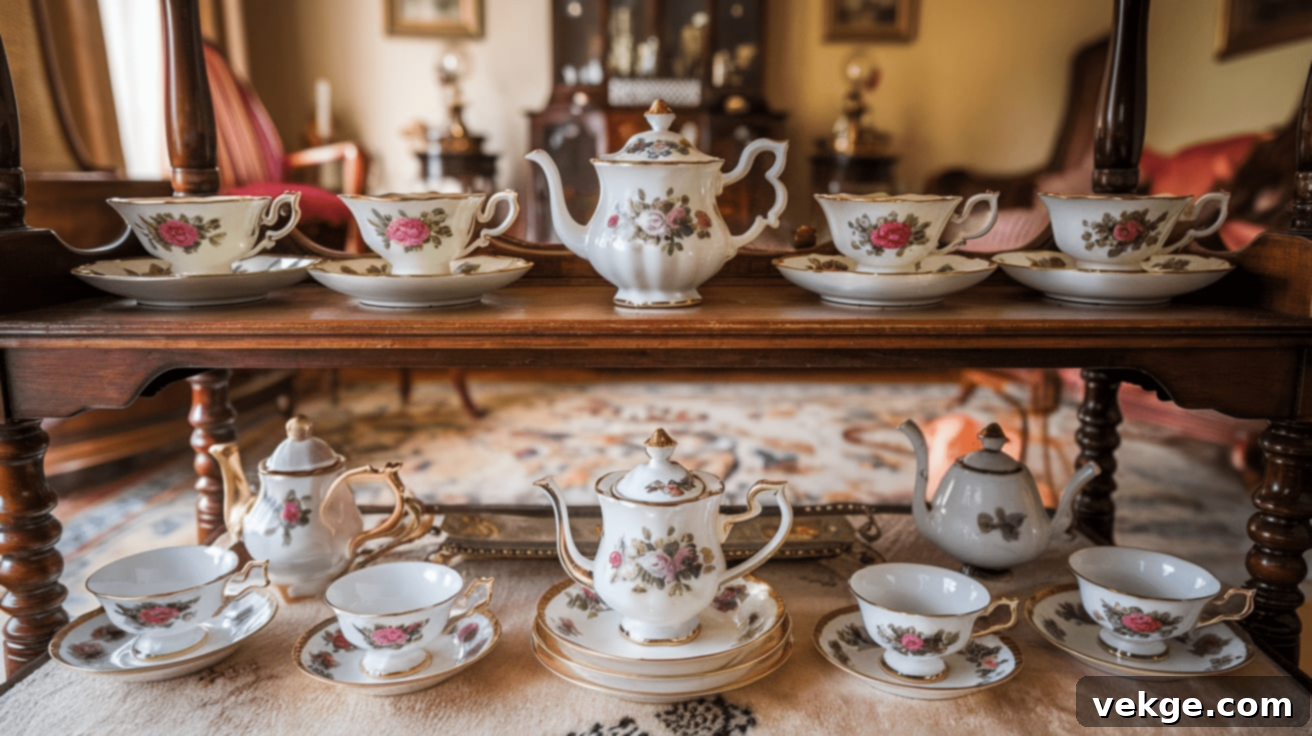
In the Victorian living room, antique tea sets were much more than just crockery; they were cherished heirlooms and symbols of social grace, narrating tales of old-time elegance and refined hospitality. These delicate porcelain pieces, often made of fine bone china, glittered and shone when displayed on polished wooden shelves, within glass-fronted cabinets, or on an elegant side table, ready for the ritual of afternoon tea.
Each cup, saucer, and teapot was typically adorned with exquisite detailing, from finely painted floral patterns in vibrant or muted hues to delicate gold edges and intricate hand-painted scenes. Many of these prized sets hailed from renowned porcelain houses in distant lands, such as China, Japan, or the esteemed potteries of England, adding an international flair to the domestic scene. Victorians took immense pride in showcasing their special tea collections, treating them as artistic displays as much as functional items.
Guests would often admire the beautiful array of cups and saucers, sometimes even discussing their provenance or unique designs. For a truly captivating display, position your antique tea set where soft, indirect light can make the delicate patterns and gilded accents sparkle. These tea sets are far more than mere dishes; they are tangible treasures that gracefully bridge the past with the present, bringing a rich sense of history and sophisticated charm into your home.
24. Victorian Candlesticks
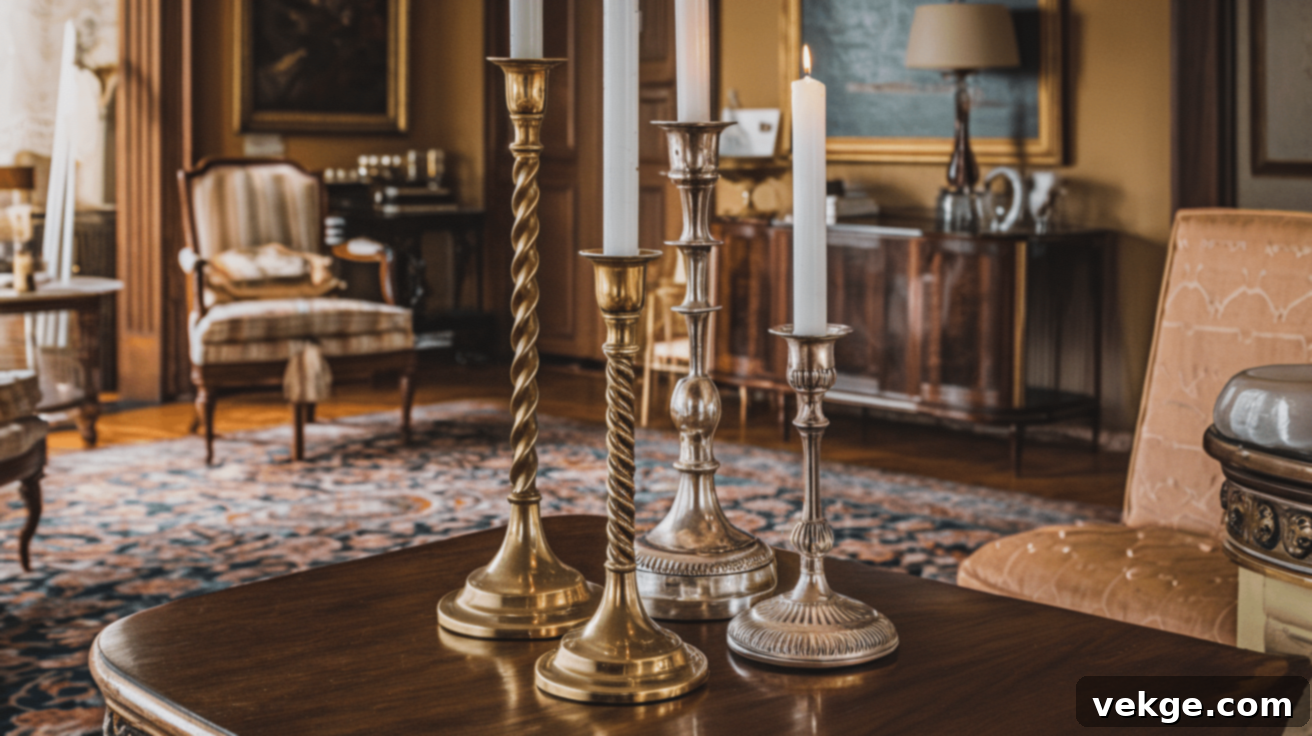
Tall, elegant candlesticks were indispensable elements in Victorian living rooms, bringing a magical ambiance and a touch of formal illumination. They stood like special guardians on tables, mantelpieces, and shelves, their presence adding height and sculptural interest to any surface. Some were crafted from shiny brass, featuring elaborately twisted designs, classical columns, or intricate scrollwork that caught the light beautifully. Others gleamed in polished silver, adorned with delicate patterns and engraved details that spoke of refined taste.
Victorians cherished the soft, warm glow of candlelight in their homes, especially during evening gatherings, as it created an inviting and romantic atmosphere. For a balanced and aesthetically pleasing look, place them in pairs, often flanking a mirror, a clock, or another central decorative item. Adding pristine white or soft cream-colored candles completes the classic Victorian aesthetic, enhancing their elegant form.
These candlesticks are much more than simple light holders; they are beautiful decorative objects in their own right, each telling a silent story of old-time elegance and sophisticated decor. Their intricate designs and reflective surfaces contribute significantly to the layered, rich visual texture characteristic of a Victorian interior, making them essential for capturing the period’s charm.
25. Luxe Throw Blankets
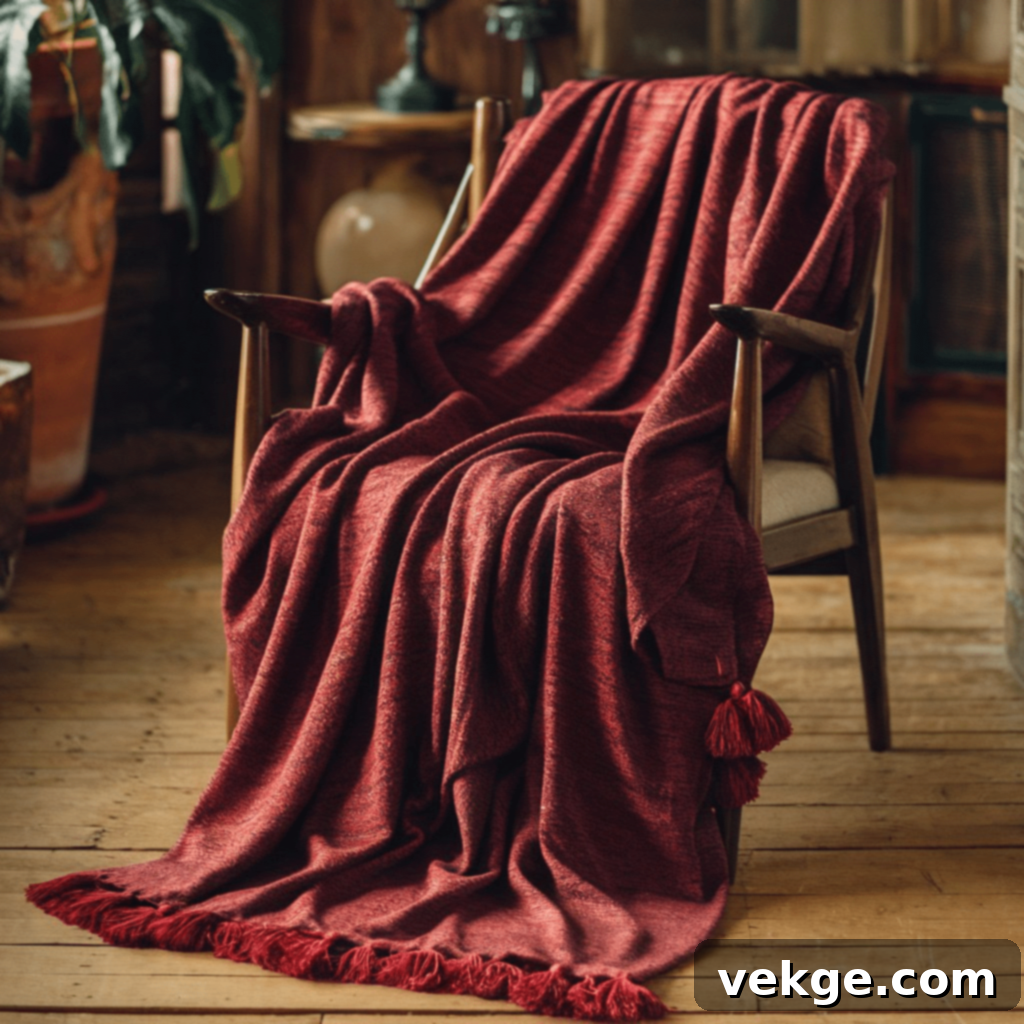
Luxe throw blankets, carefully selected for their rich textures and colors, are an effortless way to make any Victorian-inspired room feel incredibly warm, inviting, and sumptuously cozy. Embrace deep, jewel-toned colors that were emblematic of the Victorian era, such as profound deep red, rich forest green, or regal royal blue, to instantly evoke the period’s luxurious aesthetic. Drape them artfully over the back of armchairs, or fold them neatly on sofas, allowing their luxurious fabrics to add visual depth and comfort.
Throws made from velvet, plush wool, or faux fur inherently add a layer of opulent luxury to any living space. They are not merely practical items for warmth but vital decorative elements that bring comfort, texture, and sophisticated style to your home. Some throws further enhance the Victorian look with fancy woven patterns, damask designs, or soft, elegant tassels along their edges. Victorians were masters at adding layers of texture and fabric to their rooms, creating an environment that was both visually rich and incredibly comfortable.
These carefully chosen blankets transcend their function as mere soft covers; they are beautiful decorations that implicitly invite you to relax and sink into the room’s luxurious embrace, contributing significantly to the opulent and welcoming atmosphere of a Victorian living room.
26. Gilded Picture Frames
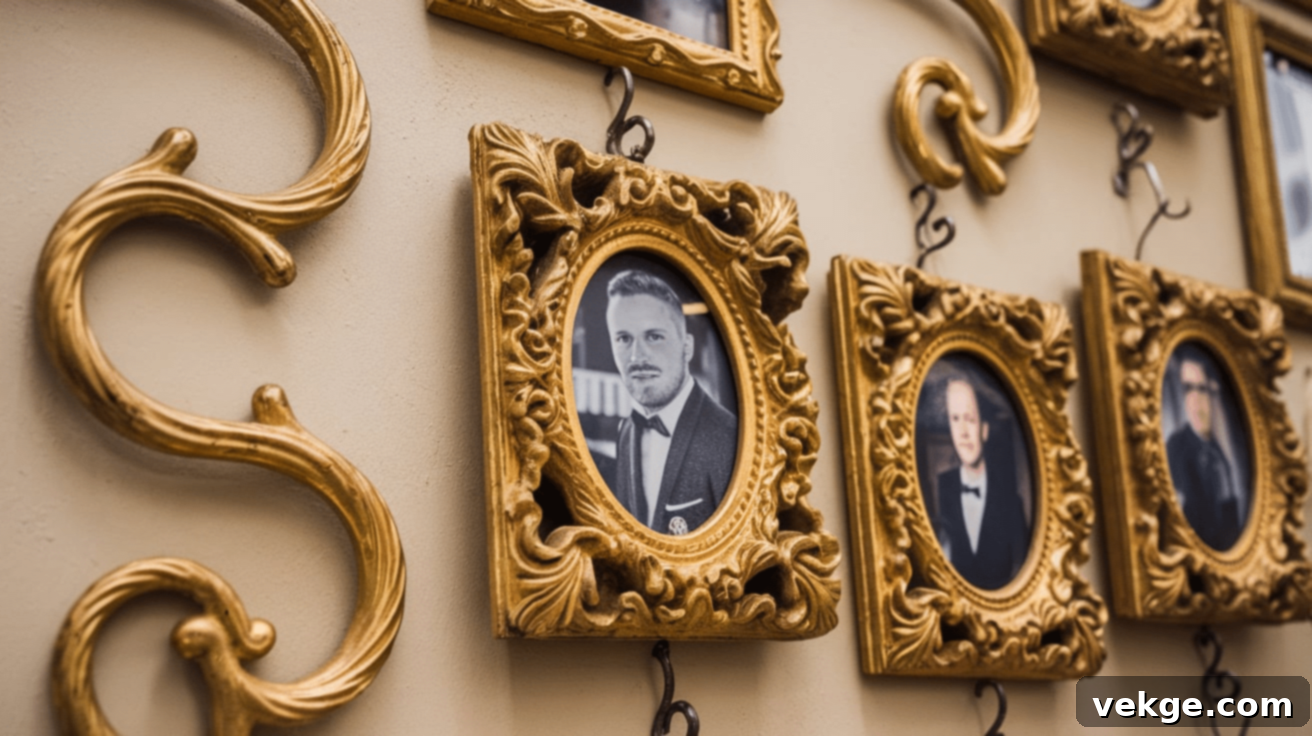
Gilded picture frames are indispensable elements for any Victorian-inspired living room, transforming simple images into radiant works of art that make memories shine bright. These fancy gold frames, often intricately designed, possess an inherent ability to catch everyone’s eye, drawing attention to the precious contents within. They instantly elevate photographs, prints, or paintings, turning them into beautiful, gallery-worthy art pieces.
To fully embrace the Victorian aesthetic, hang cherished family pictures, antique prints, or old landscape paintings within these special frames. The lustrous gold edges of the frames exude an air of undeniable fanciness and timeless elegance, perfectly complementing the rich color palettes and elaborate decor of the era. Many Victorian-style frames feature charming twisty designs, intricate rococo scrolls, or fancy curved details that add to their ornate appeal.
Victorians were keen on displaying their family history and artistic tastes, and gilded frames were the ultimate vessel for this. These frames do more than simply hold pictures; they are historical artifacts in themselves, eloquently telling stories of love, treasured memories, and special moments, all while contributing significantly to the opulent and layered visual texture of a Victorian living room.
27. Floral Wallpaper

Floral wallpaper was a cornerstone of Victorian interior design, a beloved way to bring the beauty and abundance of gardens directly inside the home, creating a sense of natural opulence. Imagine large, blooming roses, delicate lilies, soft wildflowers, or intricate botanical patterns dancing gracefully across your walls, transforming plain surfaces into vibrant tapestries. To achieve an authentic Victorian look, opt for wallpaper patterns in classic colors such as deep green, soft dusty pink, or rich burgundy, which were highly favored during the period.
These captivating patterns instantly make rooms feel alive, deeply personal, and uniquely special, reflecting the Victorian fascination with nature and decorative arts. Victorians passionately loved bringing elements of the natural world indoors, and exquisitely designed floral wallpapers were a primary means of achieving this. Each flower, leaf, and vine within the pattern tells a different story, adding narrative depth to the room’s decor.
Some of these patterns are so elaborate and beautifully rendered that they resemble fancy paintings, elevating the entire wall to a work of art. Hanging such wallpapers is an effective way to make your living room feel warm, magical, and deeply immersive. They effortlessly turn plain walls into wonderful, intricate art pieces, setting the perfect backdrop for your Victorian-inspired sanctuary.
28. Decorative Room Dividers
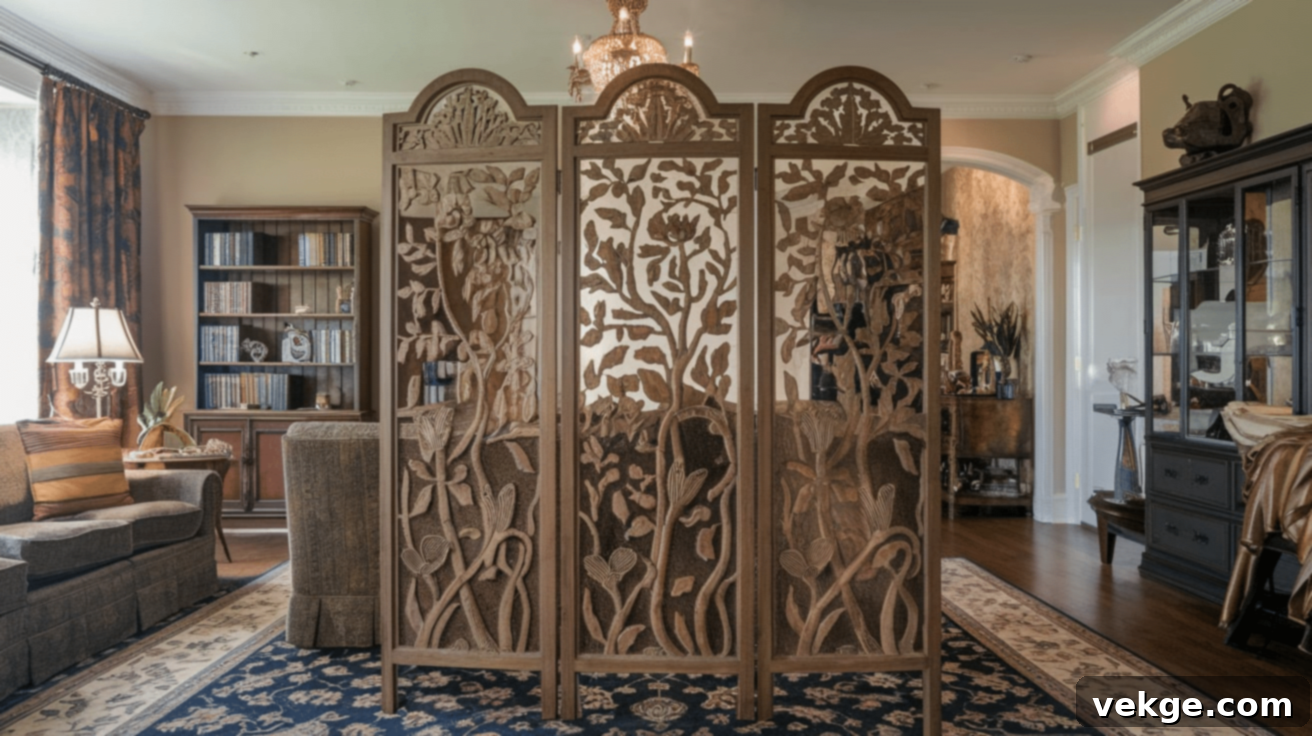
Decorative room dividers were ingenious and elegant solutions in Victorian living spaces, creating a sense of magic, intimacy, and defined areas. They effectively broke up large, often expansive rooms into cozier, more functional sections, allowing for varied activities within a single space. To truly capture the Victorian aesthetic, choose dividers with elaborate wood carvings, intricate fretwork, or beautifully painted silk panels. Some designs even feature delicate flower patterns or subtle gold details, adding to their sophisticated charm.
Victorians had a particular fondness for creating special, semi-private spaces within their grand rooms, whether for quiet conversation, reading, or a game of cards. Position these versatile dividers strategically between seating areas to create distinct zones, or near windows to filter light and add visual interest. They are also excellent for cleverly hiding messy corners, concealing storage, or creating private spots for reflection or work.
These beautiful screens are far more than mere functional walls; they are captivating art pieces that eloquently tell stories of old-time elegance and ingenious design. They add layers of texture, pattern, and visual intrigue, making your Victorian-inspired living room feel both grand and intimately inviting.
29. Faux Animal Trophies
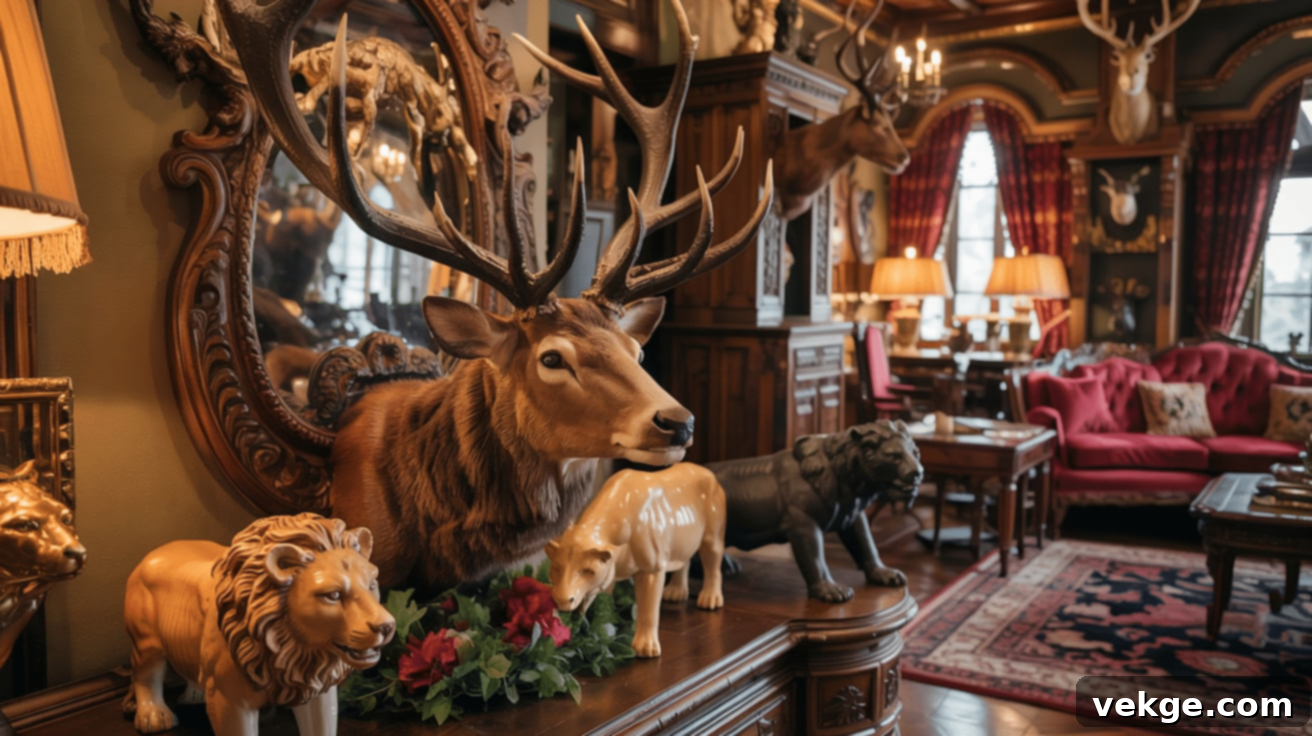
Faux animal trophies offer a distinctive way to bring a touch of adventurous and exotic flair to your Victorian-style living room, evoking the spirit of exploration and the hunt without compromising modern ethical sensibilities. These decorative items successfully replicate the appearance of hunting memories and grand game without harming any real animals. To achieve this aesthetic, select elegant deer heads crafted from carved wood, intricate resin, or ceramic animal statues that reflect a refined taste.
Many faux trophies incorporate tasteful gold or silver details that catch the light, adding a subtle sparkle and a sense of luxury to their rustic charm. Victorians delighted in showcasing interesting and sometimes exotic decorations, reflecting their travels and interests. Place these sophisticated trophies strategically on walls as striking focal points, or arrange smaller animal statues on shelves and mantels to create engaging vignettes.
They serve as conversation starters and tell imaginative stories of far-away places and exciting adventures, even if purely fictional. These decorations do more than just look pretty; they make rooms feel grand, imbued with a sense of history, and full of evocative imagination, perfectly blending with the eclectic and layered aesthetic of a Victorian interior.
30. Antique China Cabinets
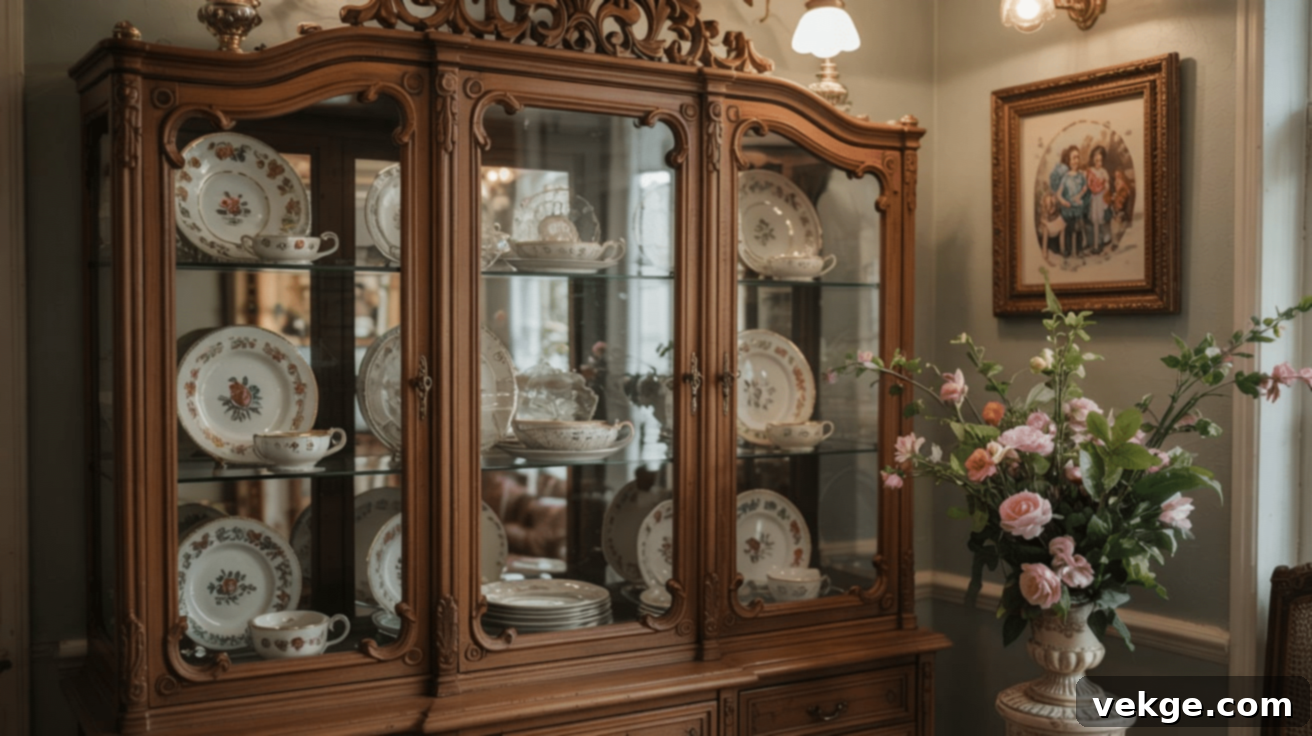
Antique china cabinets are exquisite pieces of furniture that gracefully tell stories of beautiful dishes, cherished heirlooms, and generations of family memories. These special glass-fronted cabinets were essential in Victorian living rooms, designed to proudly show off delicate porcelain plates, exquisite teacups, and other fine tableware, transforming everyday items into decorative displays. To achieve an authentic look, choose cabinets with richly carved wood edges, intricate moldings, and gleaming glass doors that allow the contents to sparkle.
Some antique china cabinets are further enhanced with elegant gold details, delicate inlays, or other fancy decorations, adding to their opulence. Victorians took immense pride in displaying their best china, often reserved for special occasions, for everyone to admire, reflecting their social standing and refined tastes. Strategically place these cabinets in prominent corners or against a feature wall where their grandeur can be fully appreciated.
Beyond their aesthetic appeal, they also serve the practical purpose of protecting special china from dust and damage, keeping these fragile treasures safe. These cabinets are much more than mere furniture; they are beautifully crafted treasure boxes that encapsulate family history, keeping it alive and beautifully presented, making them an indispensable element for a truly Victorian living room.
31. Victorian Floor Lamps
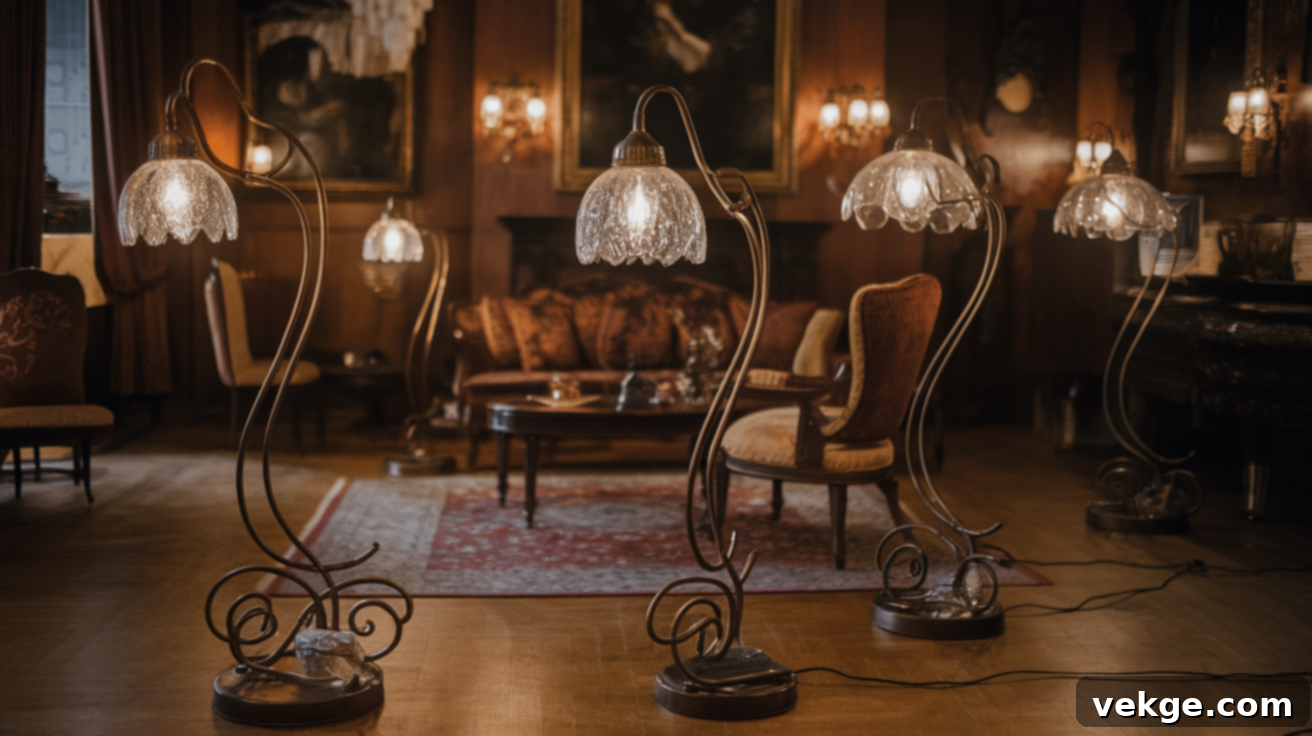
Victorian floor lamps bring a delightful blend of warm, ambient light and fancy, period-appropriate style to your living room, acting as elegant vertical accents. These tall lamps typically feature gracefully curvy metal bases, often crafted from bronze, brass, or wrought iron, which rise to support beautiful and often ornate lampshades. Some designs incorporate delicate glass details or crystal embellishments that sparkle charmingly when the lamp is lit, adding another layer of visual interest.
To truly capture the Victorian essence, select lamps with bases in classic bronze or brass colors, materials favored for their richness and durability during the era. Victorians were adept at creating soft, warm, and inviting lighting schemes in their homes, and floor lamps played a key role in adding pools of light for comfort and reading. Position them thoughtfully near sofas or in quiet reading corners, where their directed light can enhance coziness and functionality.
These lamps do more than simply light up rooms; they are like tall, sculptural decorations that contribute significantly to making spaces feel cozy, elegant, and historically rich. Each Victorian floor lamp, with its distinctive design and warm glow, tells a silent story of old-time beauty and sophisticated interior aesthetics, making it a valuable addition to your Victorian-inspired decor.
32. Beaded Lamp Shades
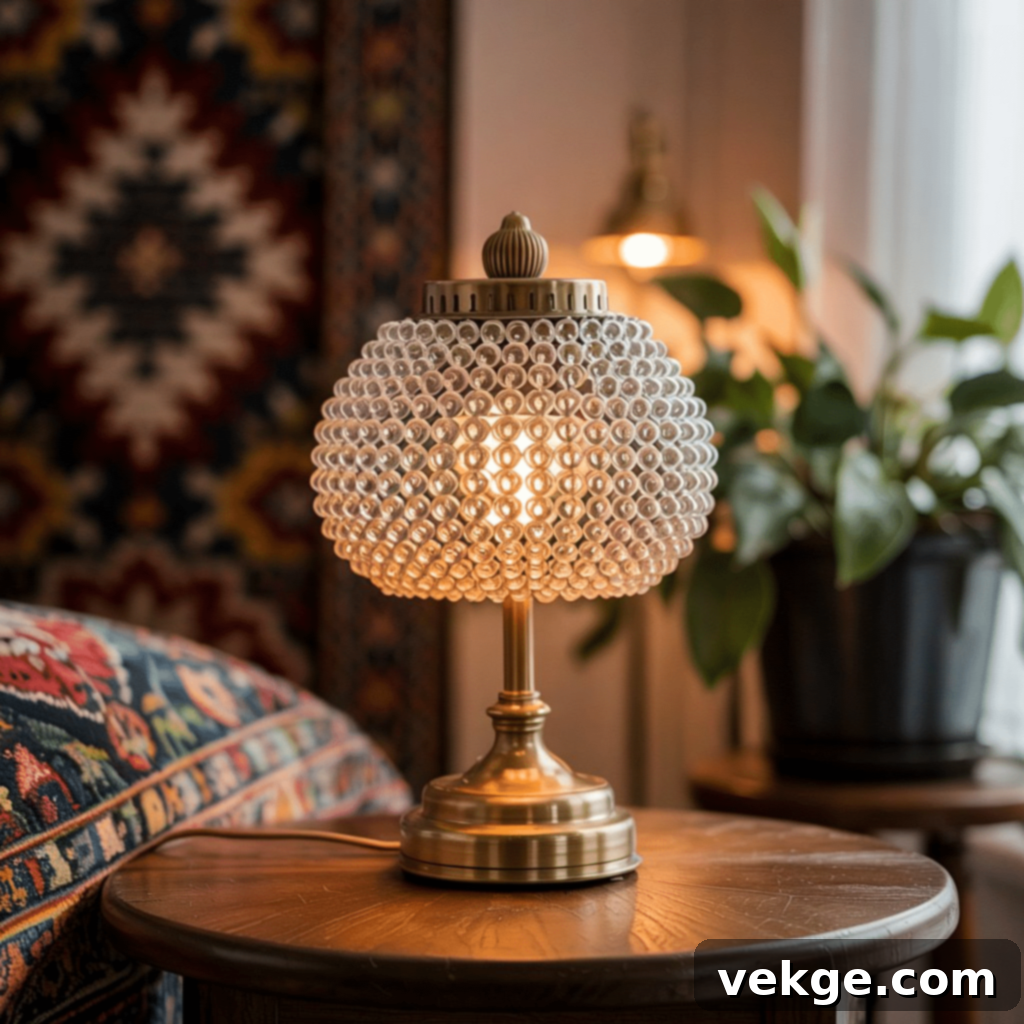
Beaded lamp shades are a captivating element that can make your Victorian-inspired rooms sparkle with a magical, almost ethereal glow. Imagine tiny glass beads, delicate crystal droplets, and soft, luxurious fringes gracefully hanging from the edges of lamp shades, catching the light and creating enchanting, dancing shadows on your walls and ceiling. These intricate embellishments were a hallmark of Victorian decorative opulence, adding a layer of delicate texture and shimmer.
To best achieve this look, choose shades adorned with clear, colored, or crystal-like beads that reflect light beautifully. Victorians had a profound appreciation for adding special, intricate details to everything in their homes, believing that beauty lay in the smallest embellishments. Place these exquisitely beaded lamps on side tables, console tables, or near cozy chairs where their details can be admired up close and their light can create an intimate ambiance.
The beads not only shine but also subtly move and shimmer when light passes through them, creating a dynamic visual effect. These lamp shades transcend their function of merely covering bulbs; they are like tiny, wearable pieces of jewelry for your lamps, instantly making rooms feel fancy, luxurious, and wonderfully unique, deeply echoing the decorative spirit of the Victorian era.
33. Decorative Trunks

Vintage decorative trunks offer a remarkable way to infuse your Victorian living room with a sense of adventure, history, and practical storage. These substantial wooden boxes, often bound with leather straps, reinforced with metal corners, and adorned with various latches and hardware, eloquently tell stories of old travels, grand voyages, and forgotten treasures. Each trunk carries a unique patina and character, hinting at its past journeys and previous owners.
To select the perfect trunk, look for those with interesting decorations, sturdy construction, or beautifully aged looks that convey an authentic sense of history. Beyond their decorative appeal, these trunks are incredibly versatile; they can hold blankets, serve as a discreet repository for books, or safely store special treasures, helping to keep your living space organized. Place them next to sofas to function as unconventional end tables, or utilize a larger, sturdier trunk as a unique coffee table, instantly adding a focal point with a narrative.
Victorians were avid collectors of interesting objects from around the world, and trunks were often central to their travels and storage needs. These decorative trunks do more than provide storage; they are like magical boxes that make rooms feel mysterious, exciting, and deeply connected to a bygone era, perfectly complementing the eclectic and story-rich aesthetic of a Victorian home.
34. Brocade Upholstery
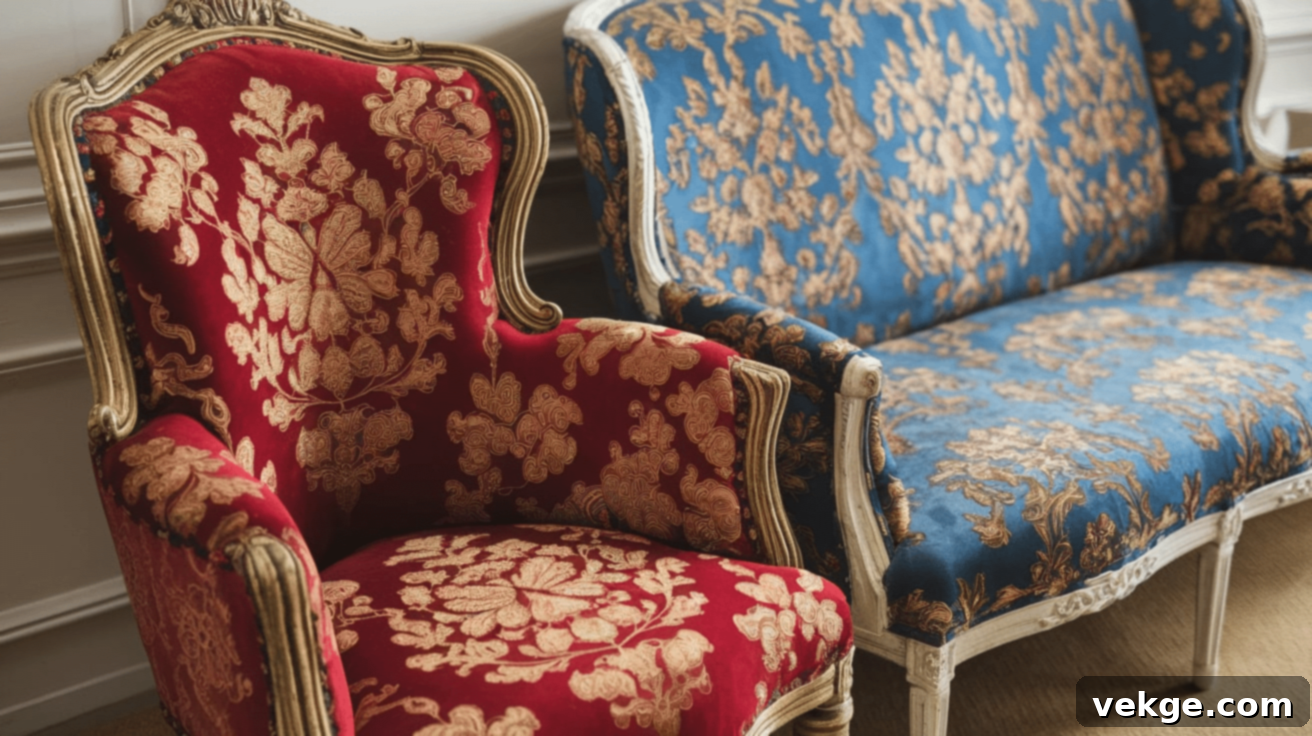
Brocade fabrics are the epitome of luxury and sophistication, making furniture upholstered in this material look exceptionally fancy and opulent, a true hallmark of Victorian interior design. These special woven cloths are distinguished by their richly raised patterns, often featuring intricate floral designs, classical motifs, or elaborate scrollwork, which catch the light beautifully and create a stunning three-dimensional effect. The tactile and visual richness of brocade instantly elevates any piece of furniture it adorns.
To fully embrace this lavish aesthetic, select sofas and chairs upholstered in brocade with deep, jewel-toned colors such as luxurious red, profound forest green, or regal royal blue, colors that were highly favored during the Victorian era. The intricate patterns, which often resemble finely detailed paintings or tapestries, add layers of visual interest and sophistication. Victorians were passionate about making their furniture look as rich, beautiful, and impressive as possible, and brocade was a premier choice for achieving this effect. Some brocade fabrics even incorporate lustrous gold or silver threads that sparkle, further enhancing their opulent appeal.
When you sit on furniture upholstered in such exquisite fabric, you can’t help but feel a sense of royalty and historical grandeur. These special upholstered pieces transcend mere comfort; they transform simple furniture into magnificent works of art, embodying the lavish and detailed spirit of a Victorian living room.
35. Gilded Side Tables
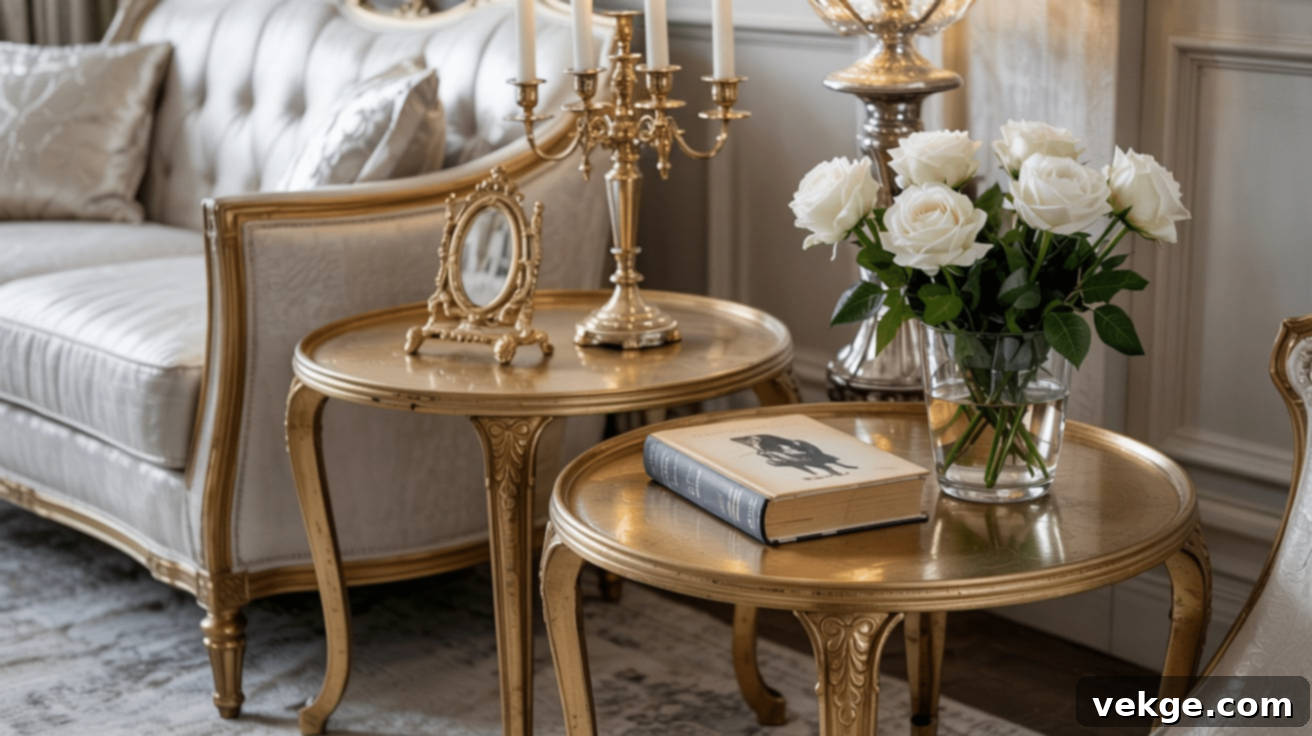
Gilded side tables are delightful accents that effortlessly bring a spark of luxurious shimmer and historical elegance to any Victorian living room. These special tables, often with delicate wooden frames or cast metal bases, are lavishly finished with gold or silver colors, making them gleam and catch the light beautifully. Their radiant surfaces instantly make spaces look fancy, opulent, and thoughtfully decorated. Some gilded tables feature exquisitely curved legs, intricate rococo details, or delicate, finely carved edges, all contributing to their ornate charm.
Strategically place them next to sofas, plush armchairs, or in cozy reading nooks. They serve as perfect perches for a cup of tea, a beloved book, or a small, carefully chosen decorative item like a crystal vase or a framed photograph. Victorians had a profound appreciation for showcasing beautiful furniture and decorative objects, and gilded side tables perfectly fit this aesthetic, acting as miniature pedestals for treasured items. These tables are much more than just places to set things; they are like small, sparkling pieces of art that imbue rooms with a special, refined character.
The luminous gold and silver surfaces of these tables eloquently tell stories of old-time elegance and sophisticated taste, making them indispensable for achieving an authentic and glamorous Victorian interior.
36. Piano with Decorative Cover

Pianos were not just musical instruments but grand centerpieces in Victorian living rooms, symbolizing culture, education, and social standing. It was common for almost every middle-class family to possess a piano, even if musical talent was not abundant in the household. A majestic grand piano was the ultimate display of wealth and prestige, but upright pianos were a more common and practical choice for most homes, still offering an impressive presence.
During the Victorian era, pianos were often draped with elegant and elaborate cloths when not in use. These decorative covers, typically made of rich velvet or embroidered silk, were adorned with sumptuous tassels, intricate embroidery, and luxurious fringes hanging from their edges, protecting the instrument while adding another layer of opulent decor. Today, even a smaller upright piano can instantly contribute significant Victorian charm and a focal point to your living room.
If you don’t play, consider a digital piano designed with an old-fashioned cabinet to capture the aesthetic. To complete the look, add a beautiful decorative scarf, perhaps with tassels or lace, draped artfully across the top. Further enhance the Victorian ambiance by placing family photos in ornate frames or a pair of elegant candlesticks on your piano, creating a tableau that speaks of historical grace and domestic refinement.
37. Pressed Flower Art
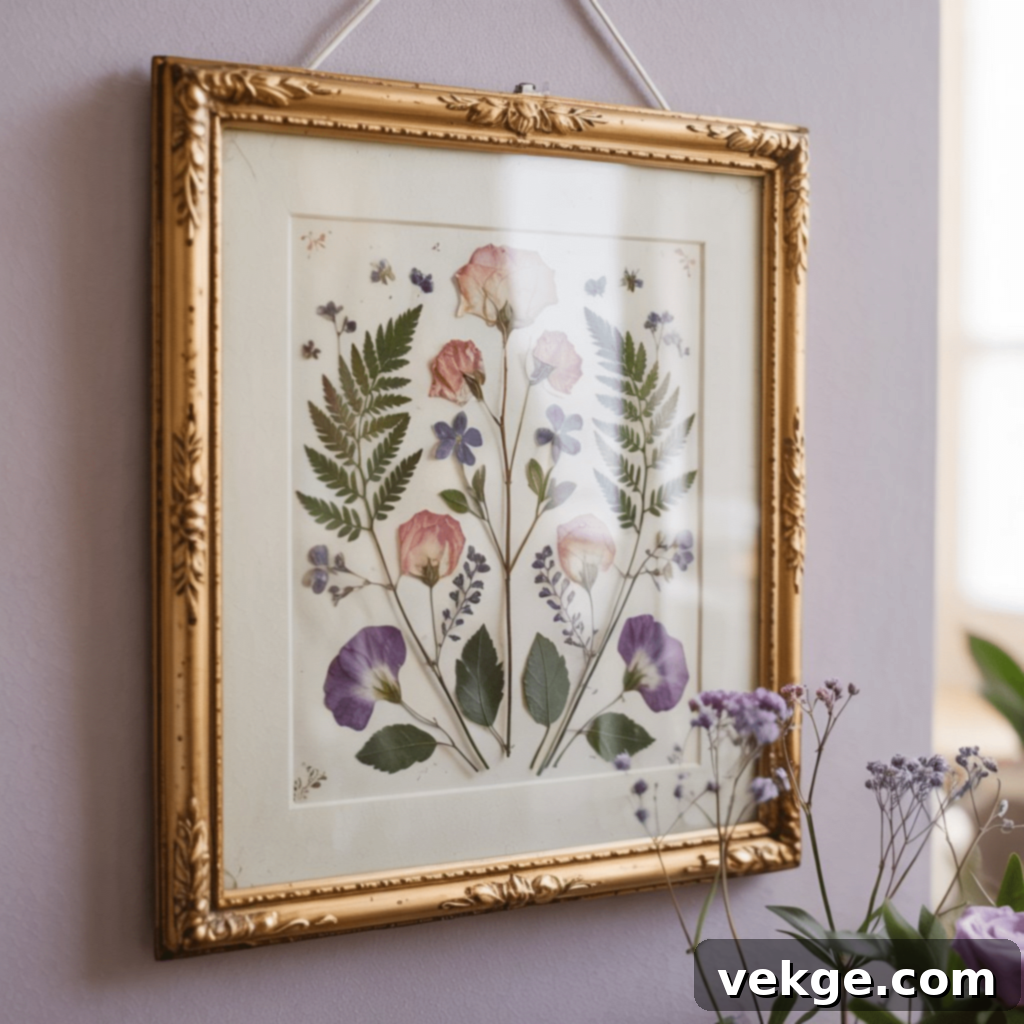
Victorians cherished pressed flower art, a delicate and sentimental form of decoration that brought the subtle beauty of the natural world indoors. This popular hobby involved carefully collecting various plants and flowers, meticulously pressing them flat, and then artfully arranging them into pretty patterns or picturesque scenes. These preserved botanical creations were then displayed in elegant glass frames, adorning walls or resting on tables, acting as charming vignettes of nature’s artistry.
It was a beloved pastime, especially among women, who spent countless hours pressing flowers between the pages of heavy books or using specialized wooden presses. Popular flora included the romantic rose, delicate violet, lush ferns, and the sentimental forget-me-not, each chosen for its beauty and symbolic meaning. You can easily create your own pressed flower art using blooms from your garden, offering a personal and cost-effective way to add this touch.
Alternatively, seek out vintage pressed flower art at antique shops or flea markets, where you might discover authentic pieces with historical charm. For the most quintessential Victorian look, ensure your pressed flower arrangements are housed in frames with ornate gold edges. This natural and delicate decoration brings a distinctly romantic, whimsical, and utterly charming touch to any living room, softening the grandeur with botanical grace.
38. Victorian Tea Trays
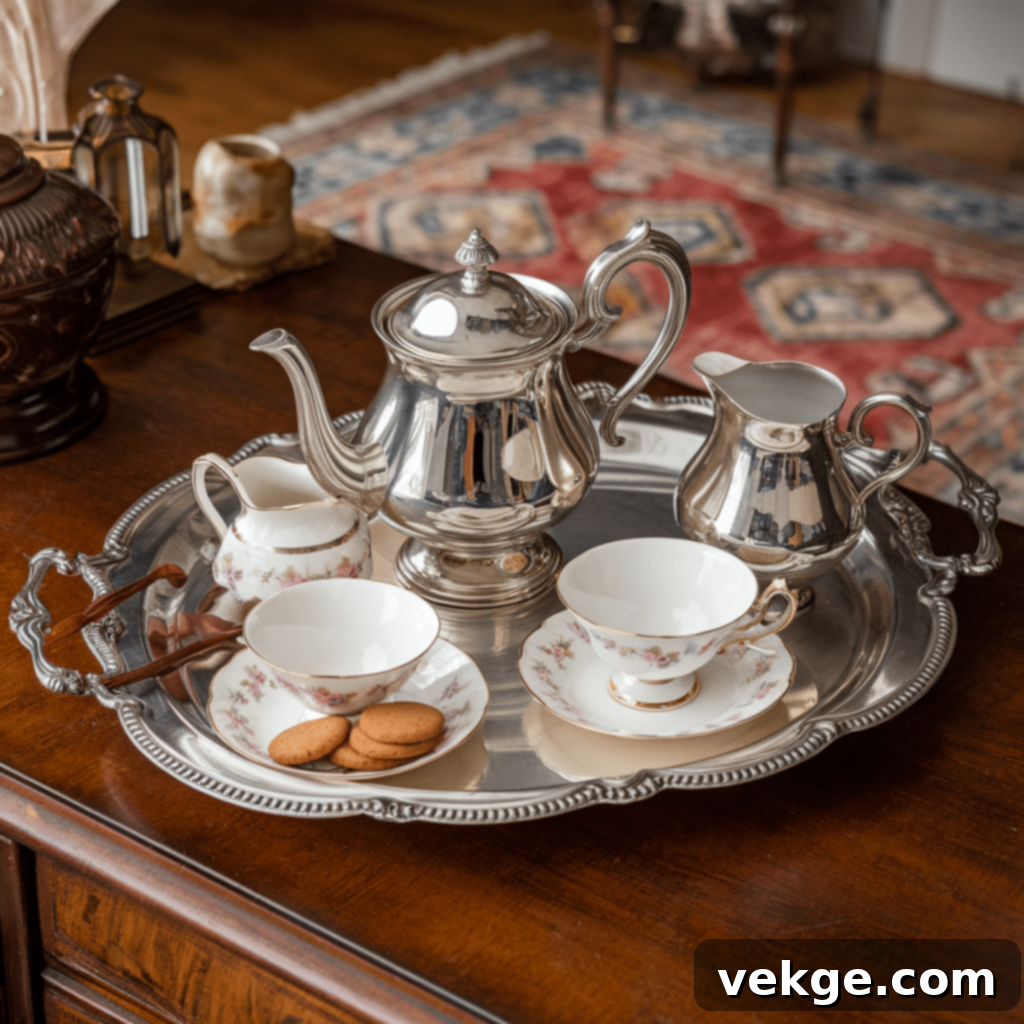
Tea time was an exceedingly important and ritualized social event for Victorians, making elegant tea trays indispensable for serving teapots, cups, and an array of delectable treats with grace. These trays were meticulously crafted to be both highly functional and exquisitely beautiful, reflecting the period’s dedication to refined domesticity. Silver tea trays, often intricately engraved or embossed, were particularly prized and served as clear indicators of a family’s wealth and social standing, gleaming under the gaslight.
Wooden trays, often featuring delicate inlaid designs, hand-painted patterns, or mother-of-pearl accents, were also popular, offering a warmer, more natural aesthetic. Many trays were designed with small, raised edges to prevent items from sliding off, and convenient handles on the sides for easy carrying. Today, vintage tea trays make for wonderful and authentic Victorian decorations, even when not actively used for serving.
Place one on a coffee table as a stylish base for an arrangement of pretty cups, a small plant, or other decorative objects. You can also hang particularly ornate trays on walls as unique art pieces, adding metallic luster and historical texture. Even when not employed for their original purpose, these trays instantly add an authentic Victorian charm and a touch of refined ritual to any living room, inviting contemplation and conversation.
39. Decorative Cages
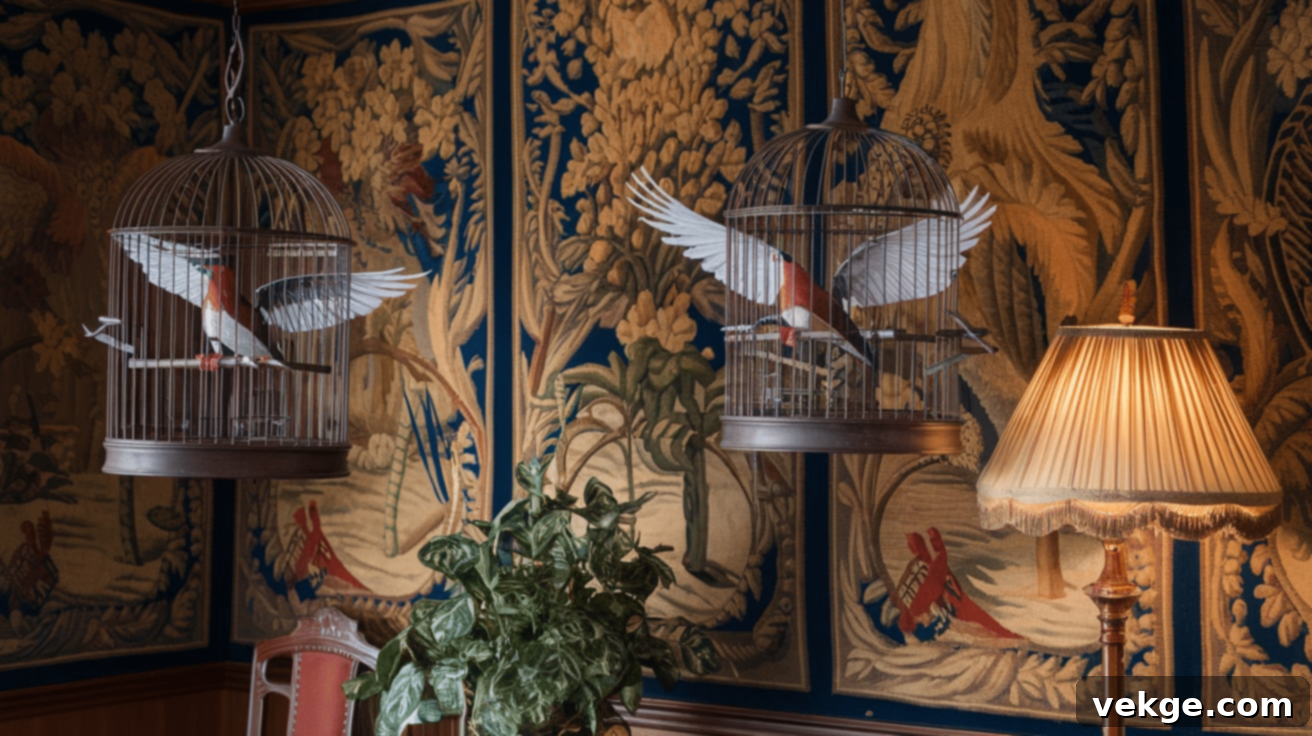
Victorians had a particular penchant for displaying fancy decorative birdcages in their living rooms, which often served purely aesthetic purposes rather than housing actual birds. These charming cages, often intricately designed, were made from materials such as polished brass, sturdy wrought iron, or finely turned wood, frequently featuring detailed scrollwork, delicate wire designs, or ornate architectural elements. Some cages boasted elegant domed tops and stood on fancy, elaborate stands, transforming them into sculptural works of art.
Today, you can readily find empty vintage birdcages at antique shops, flea markets, or through online vintage retailers, or discover newly manufactured ones designed to replicate the old-world charm. Integrate them into your decor by placing them on prominent tables, sideboards, or by hanging them from hooks, allowing their unique silhouettes to draw the eye. For a whimsical touch, fill them with faux birds, small potted plants, delicate fairy lights, or battery-operated candles that cast a soft glow.
These unique and often whimsical pieces add a distinctive touch of Victorian whimsy, romance, and an old-world curiosity to any room. Their intricate designs and often grand scale make them captivating decorative accents, perfectly embodying the eclectic and detailed nature of Victorian decor.
40. Faux Fur Throws
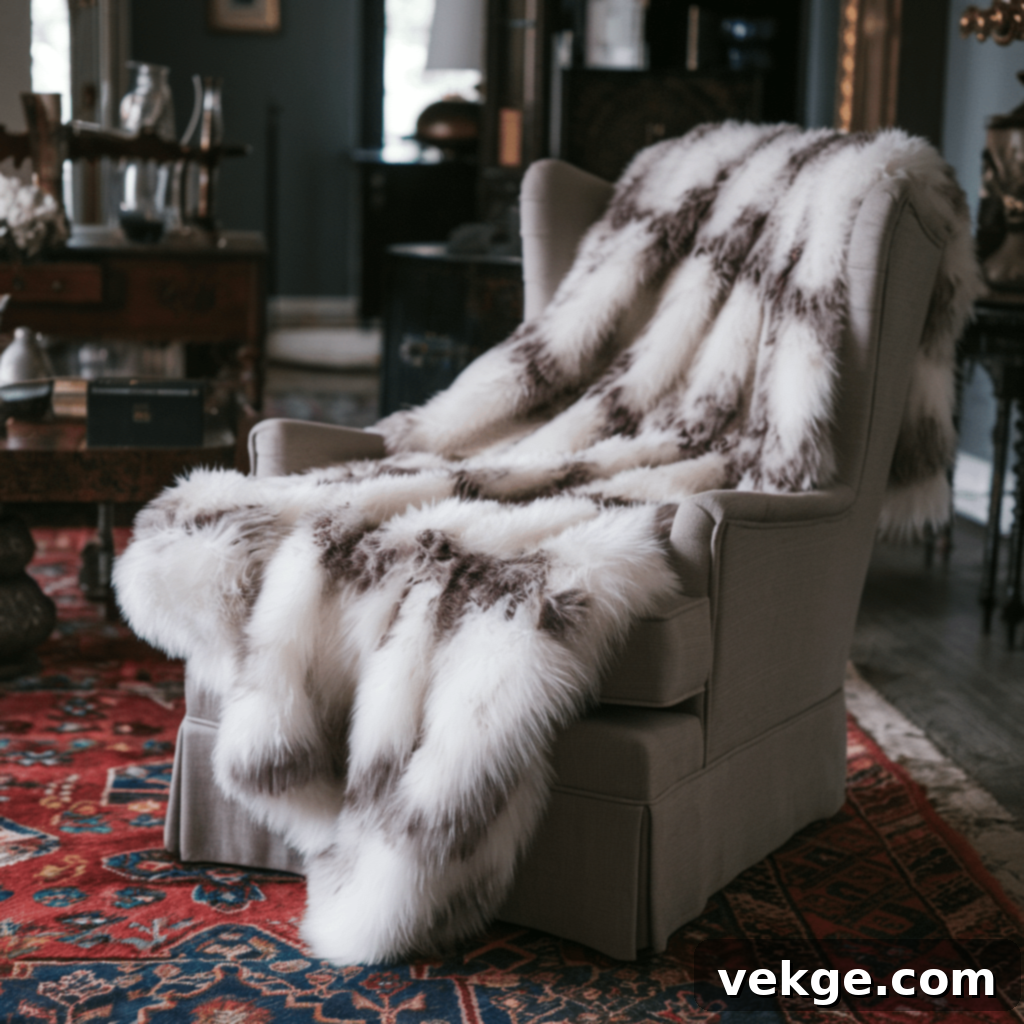
While Victorians, particularly those of means, would have used real animal fur blankets for warmth and as a symbol of their wealth and status, today we can achieve a similar luxurious effect with ethical faux fur throws. These exquisitely soft blankets perfectly mimic the look and feel of real fur without any harm to animals, offering a conscious yet opulent decorative choice. Drape a lavish faux fur throw artfully over your sofa, an armchair, or the foot of a chaise lounge for an instant injection of luxury, texture, and visual warmth.
To align with the classic Victorian aesthetic, opt for faux fur in deep, rich colors such as sumptuous brown, elegant white, sophisticated gray, or even darker, more dramatic tones. The wonderfully fuzzy texture of faux fur immediately adds an inviting softness and tactile warmth to any room, counterbalancing some of the harder lines of traditional furniture. Faux fur throws are incredibly pleasing to touch and provide excellent comfort on chilly evenings, making them both beautiful and practical additions.
They also serve as fantastic backdrops for layered decor, or for creating a cozy, inviting vignette. Even incorporating just one high-quality faux fur throw can dramatically enhance the Victorian richness and opulent comfort of a modern living room, bridging historical aesthetics with contemporary values.
41. Victorian Tapestries
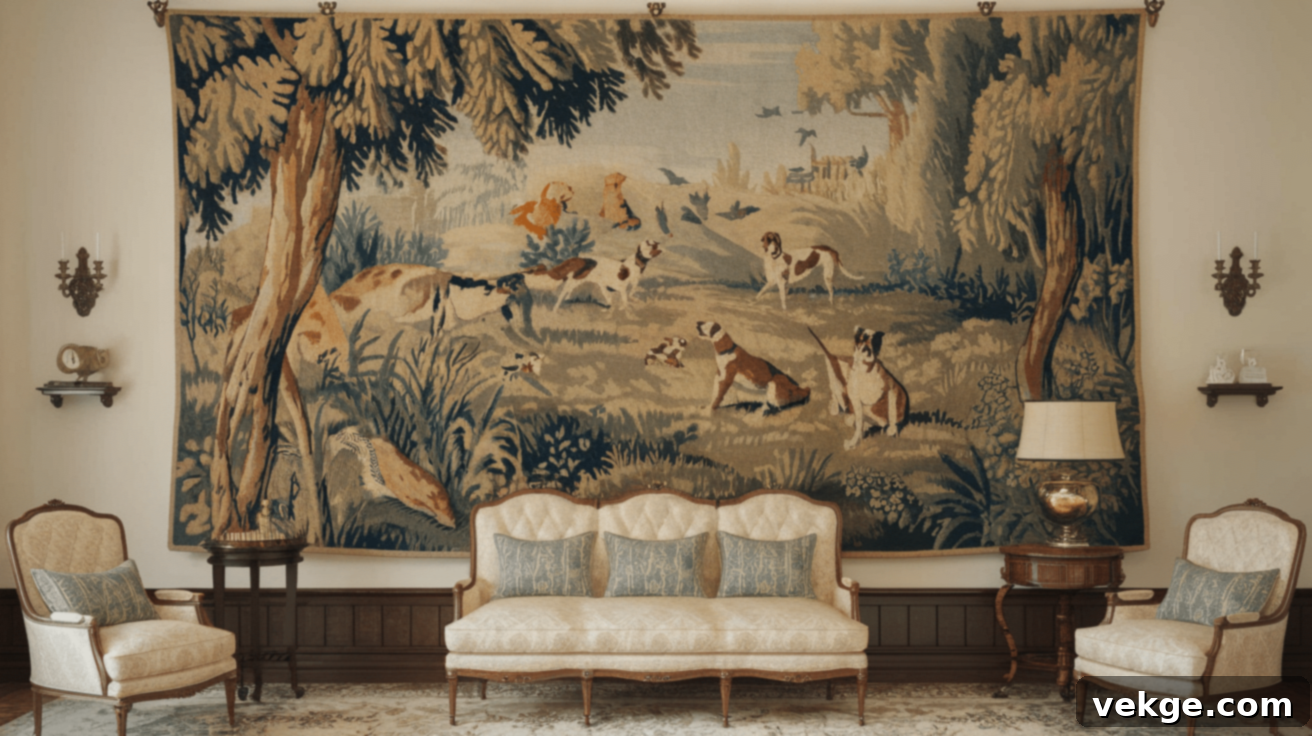
Victorian homeowners had a deep appreciation for hanging tapestries on their walls, a practice that brought both artistic beauty and practical benefits to their living spaces. These elaborate woven cloth pictures typically depicted grand nature scenes, dramatic hunting motifs, classical allegories, or intricate stories from history and mythology. The detailed fabric art, with its rich colors and complex textures, added immense visual depth, warmth, and an undeniable sense of grandeur to otherwise plain walls.
Beyond their decorative function, tapestries served a practical purpose in older homes: they helped to insulate rooms by covering cold wall surfaces, making interiors feel much warmer and more comfortable, especially during the colder months. They also possessed excellent sound-absorbing qualities, contributing to quieter and cozier rooms, a welcome respite from outside noise. Today, you can find high-quality reproduction tapestries that faithfully capture the Victorian aesthetic but are significantly more affordable and easier to maintain than genuine antiques.
Even a moderately sized tapestry can instantly imbue a room with old-world charm, historical richness, and a layered, artistic feel. Look for pieces with deeply saturated colors, intricate patterns, and narrative themes that resonate with the Victorian era. Hang them prominently on walls as a dramatic focal point, or artfully drape them over the back of a large sofa or a console table to introduce an immediate touch of luxurious Victorian flair and sophisticated texture.
How to Achieve a Modern Victorian Living Room
Creating a modern Victorian living room involves a clever and balanced fusion of two distinct eras. The goal is to design a stylish, comfortable, and highly functional space that pays homage to Victorian grandeur while embracing the clean lines and conveniences of contemporary living. This hybrid style allows you to enjoy the best of both worlds: the rich aesthetic appeal of the past and the practicalities of the present. By carefully mixing old and new styles, thoughtfully incorporating modern furniture, adding authentic vintage decorations, maintaining a lighter color palette, and seamlessly blending technology with classic looks, you can achieve a truly unique and inviting atmosphere.
Blending Modern with Vintage
The art of blending modern with vintage elements is key to creating stylish rooms that possess character, history, and contemporary relevance. To achieve harmony, select larger furniture pieces, such as your main sofa or armchairs, in simple, modern designs. This provides a clean, comfortable, and functional foundation, preventing the room from feeling overly heavy or cluttered. Against this modern backdrop, introduce smaller, but impactful, vintage elements. Think about adding antique or vintage lamps with their unique bases and shades, ornate picture frames that tell stories, or elegant vases that provide a touch of historical artistry as decorative accents.
Utilize old, leather-bound books stacked on a coffee table or a grand antique mirror as striking focal points that draw the eye and spark conversation. For an added personal touch, consider painting vintage wooden pieces, like a small side table or a console, in fresh, contemporary colors to give them a new life while retaining their classic form. The principle here is balance: ensure neither style dominates completely, but rather that they complement each other. Smartly integrate modern technology by discreetly hiding it inside vintage cabinets or storage units, maintaining the aesthetic without sacrificing convenience.
Balancing Color and Light
Traditional Victorian rooms, with their preference for heavy furniture, dark wood, and rich, deep color palettes, can sometimes feel quite dark and imposing. To achieve a modern Victorian aesthetic that feels fresh and inviting, it’s crucial to master the balance between color and light. Start by painting your walls in lighter, more expansive hues such as soft cream, delicate pale gray, or a serene light blue. These colors will instantly brighten the space, making it feel more open and airy, while still providing a sophisticated backdrop.
To maximize natural light, opt for sheer curtains or lighter drapery that allows ample sunlight to filter into the room, rather than the heavy, opaque fabrics of authentic Victorian homes. Strategically place mirrors, especially large gilded ones, to bounce light around the room, making it appear larger and more luminous. For artwork, choose white or light-colored picture frames, which will stand out against the deeper tones of Victorian-inspired art and help lift the overall brightness. Light-colored rugs can work wonders in brightening hardwood floors, providing a soft contrast to dark furniture.
Finally, incorporate small touches of gold or silver accents in your decor – on light fixtures, decorative objects, or furniture hardware. These metallic elements will add a subtle sparkle and sophistication without contributing to the visual heaviness, creating a refined and airy version of Victorian opulence.
Must-Have Modern Touches
The beauty of a modern Victorian living room lies in its ability to seamlessly integrate contemporary comforts and conveniences without compromising the classic aesthetic. Victorian style, with its inherent love for detail and function, actually works remarkably well with today’s advanced technology and materials. Consider smart light bulbs in antique-style fixtures; they offer the perfect period look while allowing you to control brightness, color temperature, and ambiance with a tap, enhancing the room’s mood from cozy to bright.
Embrace new, high-performance fabrics that resist stains and wear, offering the opulent look of velvet or damask but with much greater durability and easier maintenance. Sofas and armchairs can retain classic Victorian shapes, featuring elegant curves and intricate details, but incorporate modern foam cushions that provide superior comfort and support compared to traditional horsehair or spring fillings. Think about hidden charging stations discreetly built into side tables or behind a cleverly placed antique book box, keeping your phones and devices powered without unsightly cables.
For upholstery, washable velvet is a game-changer, offering the classic luxurious appearance with the convenience of easy cleaning, perfect for modern family life. Smart speakers can be cleverly concealed inside vintage decorative boxes or old radio casings, blending seamlessly into the decor. Even heating and cooling vents can be upgraded to feature ornate, period-inspired designs, ensuring that every functional element contributes to the overall aesthetic. These thoughtful modern touches elevate the Victorian living room to a space that is both historically beautiful and perfectly adapted for contemporary living.
Budget-Friendly Victorian Living Room Ideas
Transforming your living room into a grand Victorian sanctuary doesn’t have to break the bank. With a bit of creativity, resourcefulness, and a passion for finding unique treasures, you can achieve that fancy, opulent look without spending a fortune. The secret lies in focusing on key elements like furniture restoration, strategic use of gold accents, incorporating vintage touches, and smart shopping at thrift stores. By embracing these budget-friendly strategies, you can create a cozy, elegant, and historically rich living space that feels incredibly luxurious, all while adhering to a sensible budget.
DIY Decor and Furniture Restoration
Embracing DIY decor and furniture restoration is perhaps the most rewarding and cost-effective way to infuse your living room with authentic Victorian charm. Instead of buying new, expensive period pieces, seek out old, neglected wooden furniture items at flea markets, thrift stores, or online classifieds. Sanding down wooden pieces is the crucial first step before applying a fresh, rich wood stain to bring out the natural beauty of the grain, or a coat of deep, period-appropriate paint to give them a dramatic new look.
Replace worn or missing drawer pulls with vintage-style knobs or ornate brass handles, instantly upgrading the piece’s appearance. Old chairs with good bones can be lovingly reupholstered using rich, affordable fabrics like velvet, brocade remnants, or damask patterns, giving them a luxurious new life. Repurpose old suitcases into stylish, stacked side tables, adding a touch of travel history. Plain picture frames can be ingeniously transformed into decorative serving trays with a little paint and a new base.
Learning basic woodworking skills can help you fix minor damages like wobbly legs or broken arms, ensuring your restored pieces are sturdy. Even simpler, a touch of gold spray paint can add elegant, gilded accents to plain items like vases, candle holders, or picture frames, creating a high-end look on a minimal budget.
Affordable Lighting
Creating an inviting and authentic Victorian lighting scheme is entirely possible without a hefty expenditure. Thrift stores and second-hand shops are treasure troves where you can often discover glass chandeliers that, with a thorough cleaning and perhaps a simple update to the wiring, can shine gloriously in your home. For existing plain metal lamps, a can of gold or brass spray paint can work wonders, instantly transforming them into elegant, period-appropriate fixtures that appear far more expensive than they were.
To enhance the Victorian look of simple lamps, consider adding beaded shades or shades with delicate fringe. These small additions instantly elevate the lamp’s elegance and diffuse the light beautifully, mimicking the soft glow of the era. For ambiance, battery-operated LED candles, placed in vintage holders found at antique markets or even dollar stores, provide a safe, flickering glow that perfectly captures the cozy atmosphere of gaslight and candlelight. Small crystal pendants can be easily attached to basic light fixtures, adding a touch of sparkle and luxury. Even wall sconces from discount home stores can be paired with vintage-style Edison bulbs to emit a warm, golden light, completing your budget-friendly Victorian lighting design.
Conclusion
Embarking on the journey of creating a Victorian-style living room is an incredibly fun, creative, and surprisingly affordable endeavor. The true beauty of this design approach lies in its flexibility, allowing you to blend elements of the old and the new to craft a unique space that perfectly reflects your personal taste and lifestyle. Don’t be afraid to mix authentic antique finds with modern interpretations or even contemporary pieces; the juxtaposition can often create the most captivating and character-rich interiors.
Cultivating a Victorian aesthetic is all about the hunt for treasures. Dedicate time to exploring thrift stores, antique shops, flea markets, and online marketplaces, where you can uncover hidden gems – from ornate picture frames and vintage lamps to antique rugs and unique decorative curios. These individual pieces, each with its own story, will contribute immensely to the layered and personalized feel that defines a true Victorian home.
While the Victorian era was known for its opulence, remember that “fancy” doesn’t always mean “expensive.” Focus on incorporating rich colors, luxurious textures, and intricate details wherever possible, even through DIY projects or clever repurposing. The key is to curate a collection of special pieces that genuinely resonate with you and tell a story, whether personal or historical.
Ultimately, the objective is to create a living room that feels profoundly warm, inviting, and exquisitely beautiful – a sanctuary where comfort and elegance coexist. Your Victorian-inspired living room can be a powerful expression of your personal style, gracefully bringing the timeless charm and sophisticated allure of a bygone era into the heart of your modern home.
